|
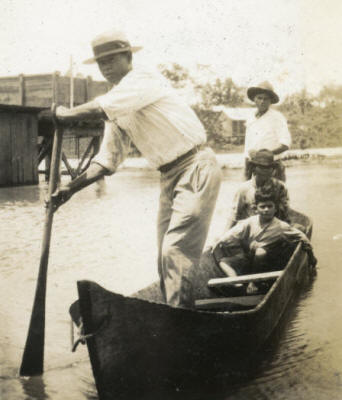 THIS IS THE THIRD PAGE
of documents for the FIRST HALF of 1932
on Nicaragua's Caribbean Coast region, housing
documents dated during the month of April.
THIS IS THE THIRD PAGE
of documents for the FIRST HALF of 1932
on Nicaragua's Caribbean Coast region, housing
documents dated during the month of April.
The
big event on the Coast
during the
month is the April 4 Guardia mutiny
at the recently established post at
Kisalaya, resulting in the death of
Guardia 1st Lt. Charles J. Levonski
— a mutiny described in considerable
detail in Col. Leech’s report of 9
April — to which is appended several
revealing eyewitness testimonies —
and in the court martial proceedings
of 11 April. Historians Neill
Macaulay & Volker Wünderich
interpret the Kisalaya mutiny as an
act of vengeance by Miskitu Indians
& the EDSN against the Guardia’s
killing of Adolfo Cockburn the
previous October (Macaulay, The
Sandino Affair (Duke, 1985),
pp. 223-25, and Wünderich,
Sandino en la Costa (Managua,
1989), p. 124 ff.). Others
disagree — most notably David C.
Brooks in his unpublished Ph.D.
dissertation (“Revolution from
Without,” U-Conn Storrs, 1997, chap.
10). Readers will judge for
themselves, but my own
interpretation accords with Brooks’
— I see nothing here to suggest that
the mutiny was inspired by a desire
to avenge Cockburn’s death, and much
to indicate that it originated in a
grudge against Levonski on the part
of its four leaders, especially Sgt.
Sebastian Jiménez; that it erupted
mainly as a result of Levonski’s
efforts to discipline his troops,
combined with excessive beer
drinking among the mutineers & their
shared sense that Levonski had
disrespected them in various ways;
and that it had nothing to do with
avenging Cockburn.
Seventeen days after the mutiny,
on April 21, Kisalaya is attacked by
a group of some 50 Sandinistas,
accompanied by an unknown number of
civilians, as described in Lt.
Francisco Gaitan’s report the
following day. Repelling the
assailants after an hour’s exchange
of gunfire, the Guardia finds among
the three dead none other than Sgt.
Jiménez, who after the mutiny had
joined the rebels & convinced them
that taking the garrison would be
easy. Gaitan’s reports are
always worth reading, as much for
their literary qualities as their
depth of detail, which is no less
true of his previous week’s account
of his patrol’s failed search for
the mutineers, undertaken with the
active assistance of local Miskitu
(April 17).
Toward the end of the month, on
April 28, Sandino writes to Gen.
Francisco Estrada announcing yet
another expedition to the Coast, to
be undertaken by Estrada & Gen.
Pedro Antonio Irías — and telling
him that, if they do end up
establishing “el Control de ese
Litoral,” that he (Estrada) will be
named the Coast’s Gobernador
Intendente. Clearly
Sandino hopes that the coming
offensive will succeed where others
have failed in defeating the
Guardia, booting out the Americans,
and extending his rebel republic
from Las Segovias eastward to
embrace the cities & ports & foreign
properties of the Coast.
|
|
PERIOD MAPS
|
|
1894 mosquito
shore

27 MB,
library of congress
|
1920s
Standard Fruit

6.5 mb,
US National archives
|
1928 Rio wanks
Patrol

3 mb, us
national archives
|
1931 Moravian

2.4 mb,
comenius press
|
|
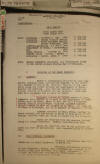
|
1 April 1932.
Extracts from
GN-2 Report Covering the Month of
March 1932.
[NOTE:
These excerpts constitute the sum total
of text devoted to the Atlantic Coast
region in this 25-page intelligence
report covering the entire country,
except Lt. Curcey’s intelligence report
of 20 January from Wauni, which is
included in chronological sequence in
these East Coast pages. The image to the
left is the report's cover page only.]
"
[p. 1]
LOCATION OF THE
ENEMY ELEMENTS. ¶ . .
. [p.
4] H. PEDRON
ALTAMIRANO. ¶ . . . March 27
– Reported moving around the north of
the Tuma River (Peña Blanca) possibly
preparing for a movement to Neptune Mine
or south into Chontales. [NOTE:
Of the 18 jefes surveyed in this
section, none were reported active in
the Eastern Area.] ¶ .
. .
[p. 5]
UNITS IN CONTACT.
[NOTE:
Of the ten contacts listed for February,
none were in the Eastern Area.] ¶
. . .
[p. 7]
STRENGTH AND
MOVEMENTS. [NOTE:
Of the 23 items in this category, none
concern the Eastern Area.] ¶
. . .
[p. 10]
SUMMARY
OF COMBAT INTELLIGENCE TO INCLUDE 7
MARCH 1932. ¶ . . .
[p.
11] EASTERN
AREA: The bandits in this
area have moved into Bocay region. They
are short of ammunition. Abraham Rivera,
personal representative of Sandino with
the bandits operating on east coast, is
reported to have gone west of Bocay for
conference with Sandino. Probably to
arrange to get ammunition and for
another raid into the Department of
Northern Bluefields. Weather has been
fine in Northern Bluefields for past two
weeks and the trails rapidly drying up.
Another raid is fully expected toward
the end of March or first of April.
It may be remembered that in the
correspondence captured from Irias in
Lt. Gray’s contact, 4 February, that he
mentioned in a letter to Sandino, the
advisability of waiting until in March
when the country was dry, to renew
operations and burn every house on the
railroad. ¶ . . .
[p.
12]
SUMMARY OF COMBAT
INTELLIGENCE TO INCLUDE 14 MARCH 1932.
¶ . . . On the East Coast it is
expected that a movement will be
attempted within the next ten days to
two weeks. ¶ . . .
[p.
13]
SUMMARY OF COMBAT
INTELLIGENCE TO INCLUDE MONDAY 21 MARCH
1932. ¶ . . .
BANDIT MOVEMENTS.
¶ . . . The Eastern Area reported
generally quiet during the past week. .
. . Latest report form a reliable source
was to the effect that a group between
300 and 400 with at least 200 rifles 100
of which were new and some men carrying
new bandoleers of ammunition were moving
in the direction of TRONCA about the
18th. This group were driving 35
head of cattle. Same agent
reported that another group was said to
be in TRONCA. TRONCA is on the
main trail from Jinotega to Wauni and
Neptune Mine. ¶ . . .
[p. 14]
ESTIMATE.
¶ . . . The bandits reported en
route to, and at TRONCA indicates that
we may expect to hear from Pedron soon.
Three possible objectives are indicated
for this group – Wauni and Neptune
Mines, La Cruz del Rio Grande, and
Chontales. The probabilities that
the direction of the movement will be
toward the mines or La Cruz del Rio
Grande, seem about even. If Chontales in
the objective, they evidently intend to
pass well to the East since they have
beef on the hoof with them. . . .
¶ [p.
15]
SUMMARY OF COMBAT
INTELLIGENCE TO INCLUDE MONDAY 28 MARCH
1932. [NOTE:
Nothing on the Eastern Area.]
¶ . . .
[p.
25]
CONSOLIDATED
REPORT OF CONTACTS OF THE GUARDIA
NACTIONAL DE NICARAGUA FOR THE MONTH OF
MARCH 1932. [NOTE:
Of the 10 contacts listed, none were in
the Eastern Area.]"
|
|
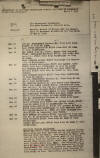
|
1.
1 April 1932.
Monthly Record of Events for the
Department of Southern Bluefields for
the Month of March 1932, Capt. Ralph
McAfee, Bluefields, p. 1.
|
|
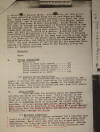
|
2.
1 April 1932.
Monthly Record of Events for the
Department of Southern Bluefields for
the Month of March 1932,
Capt. Ralph
McAfee, Bluefields, p. 2.
|
|
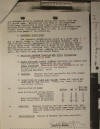
|
3. 1 April 1932.
Monthly Record of Events for the
Department of Southern Bluefields for
the Month of March 1932,
CCapt. Ralph
McAfee, Bluefields, p. 3.
|
|
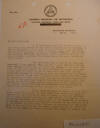
|
7 April
1932.
Letter from Col.
L. L. Leech, Bluefields, to Gen.
C. B. Matthews, Jefe Director GN
Managua, p. 1. My
dear General:- ¶ I am
anxiously awaiting Inman’s report on the
causes and events of the recent
happenings at Kisalaya. I cannot
understand it in view of reports that
since Levonski had relieved Suprenant
there, a marked change for the better
was apparent and that this entire outfit
appeared happier and more content.
A letter from Inman Saturday again
mentioned these facts. ¶ The
occurrence was a blow to us all, and
Levonski’s loss greatly felt. He was a
good officer, and always seemed to have
the good will and liking of his men.
The loss of arms and ammunition will
probably be heavy, and certainly will be
costly to us in more ways than one.
If the mutineers succeed in joining up
with the bandits on the upper Wanks with
all those arms, automatics and
ammunition that were at Kisalaya, it
will give them just what they have been
short of and we can certainly expect
trouble. I am just hoping the
planes can locate them, and be lucky
with a few bombs. It was sure a tough
break and the suddenness of it certainly
a blow in my confidence to the Guardia
in this Area. ¶ I had
directed Inman to send a patrol from
there toward Toob Roas and from Moss
Farm toward the same objective and one
from Kipla Farm to Skitko on the Rio
Bambana, all to leave Tuesday morning
for the purpose of learning the trails
and scouring the country West of the
Railroad as counter propaganda against
any anticipated movement of the bandits
from up the river. A patrol from
Neptune is scouring the territory East
of the mine and one from Wauni left
Neptune to return to Wauni on the 31st.
By these patrols I had hoped to create
the . . . "
|
|
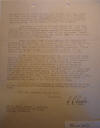
|
7 April
1932.
Letter from Col.
L. L. Leech, Bluefields, to Gen.
C. B. Matthews, Jefe Director GN
Managua, p. 2. "
. . . impression on the bandit leaders
that we were more than ready for them,
and had taken the offensive against
them. Of course the mutiny at
Kisalaya, cancelled these orders.
It is probable that the orders for the
patrol from Kisalaya precipitated the
occurrence there, for it would have been
a hard patrol . ¶ I am going up
there by the next planes for a few days
to look into conditions and try to find
out how far this mutinous spirit has
permeated Inmans command. I have
confidence in him but there must be
something back of the occurrence.
I would be there now but I hated to have
the planes lose any opportunity to make
contact with the mutineers. ¶
Under separate cover I have written you
something of conditions in Bluefields.
It strikes me that the bank officials
are not playing the game fairly and are
responsible for the actions of their
agents acting in an official capacity.
I know your policy against mixing up in
anything outside of the guardia, yet I
felt I had to explain the situation to
you. ¶ I wish I had
sufficient extra men, equipment and
transport to send a sixty man, four
officer patrol up the Coco River after
the mutineers, equipped to stay put
until their mission was accomplished,
but I can’t do it. It would take
careful planning and be a terrific
undertaking, and the transport problem
almost impossible of solution. I
have initiated a recruiting campaign
both here and in Puerto Cabezas to bring
the 9th Company up to strength again.
It is going to be difficult to get the
old timers to reenlist or extend from
now on, for they are frank to say they
do not care to be in the guardia after
the Americans leave, so our difficulties
increase instead of decreasing.
The morale of the Guardia here is high.
¶ I hope you are not having too
many worries and troubles on that side
now, and that I can stop sending you
disquieting news. ¶ With
best personal regards, I am, ¶
Cordially, ¶ L. L. LEECH"
|
|
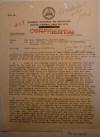
|
7 April
1932.
Conditions in Bluefields.
Col. L. L. Leech,
Bluefields, to Gen. C. B. Matthews, Jefe
Director GN Managua, p. 1.
"1. The recent
defalcation of bank funds by the book
keeper, Eustace M. Campbell, and the
actions of the bank authorities re
settlement of accounts submitted by
individuals has brought about a
situation in which there are
potentialities of trouble here. ¶
2. Many of the Creoles (about seventy in
number), had accounts in the bank and
the bookkeeper himself a Creole and
trusted by the people handled most of
these accounts, often taking in and
receipting for deposits. These
peopled acted in good faith and have
presented their bank books and deposit
slips many times and have been refused
settlement. The bank officials and
the auditor claim that each deposit slip
and bank book should be been initialed
by two bank officials, but no notice of
such a requirement was ever posted in
the bank or published in the local
papers and the public consequently knew
nothing of it until after the
defalcation became known, and then not
until individuals presented their books
and deposit slips for withdrawals.
It seems to be the policy of the bank
not to make any more restitution than it
possibly can, letting the individual
depositors take the loss. The bank
savings of these people mean a lot to
them, and as children would trust, so
they trusted the bank officials.
Therein lies the source of potential
trouble. ¶ 3. The Creole
element and depositors seem to be the
only ones destined to lose their money
and naturally they are very indignant
and excited, and can be easily aroused.
We have done our best to keep them quiet
and peacefully to prevent them getting
together in a mass meeting. I have
had their leaders in for a conference
and they assure me they will try to get
justice in a peaceful and legal way, but
they can’t sit back and see the
Government rob them. One leader
came to me this morning and stated that
an element had started the rumor that
the only way to get their money back was
to “Take” the bank. He also stated
the leaders of the Creoles were
preaching patience, and telling them
that justice would be done, but he was
afraid that unless the bank and
officials changed their . . . "
|
|

|
7 April
1932.
Conditions in Bluefields.
Col. L. L. Leech,
Bluefields, to Gen. C. B. Matthews, Jefe
Director GN Managua, p. 2.
" . . . policy
and were just, he was afraid the Creole
element might become aroused to such an
extent that trouble would result.
It is this Creole element of the
population to whom we look for aid in
case of serious trouble; most of our
Guardia, and practically all our
civicoes being Creoles. ¶ 4.
There may be a few of the claims that
need thorough investigation, but from
all I have been able to gather, the
great majority of them are just, and
deposits were made in good faith.
For that reason, and more specifically
in the interest of law and order, I
recommend that, if you can in any way
bring pressure to bear on the Bank
Officials there, for a more lenient and
generous attitude towards the claims
against the bank here, it would have a
most calming effect on the Creole
element here, moreover, if in some way
if might become known the Guardia had
brought such a change about, the
confidence of the people in the Guardia
would be greatly increased, with a
consequent beneficial effect on morale.
¶ L. L. LEECH"
|
|
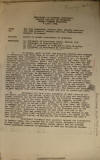
|
1.
9 April 1932.
Report on Recent Occurrences at
Kisalaya.
Col. L. L. Leech, Bluefields, to
Jefe Director GN Managua, p. 1.
"1. On Monday,
April 4, 1932, the Kisalaya Guardia were
engaged in extracting logs which were to
be used in the construction of a new
barracks. From statements of
Lieut. Reyes, reference (a), it appears
there had been discontent in the command
preceding that date, also that Sergeant
Sebastian Jimenez, #3427, had been
drinking beer that day and had become
insubordinate, refusing to obey the
orders of Lieut. Levonski, and
precipitated the mutiny, which
apparently had been contemplated for
some time, by appearing with a
sub-Thompson machine gun, and on signal
nearly all the command seized their
arms, went to their defense stations, in
a series of entrenchments all around the
cuartel and opened fire in all
directions. In the meantime,
Lieut. Levonski, after attempting
peaceably to avert trouble, started for
the barbette of the Heavy Browning
Machine Gun and was shot by Sergeant
Jimenez, who after he realized Lieut.
Levonski was not firing back, went in
and fired approximately thirty rounds
into his body. Lieut. Levonski was
apparently badly hurt, if not killed at
the first shot. Lieut. Reyes was
wounded and his statement of the details
afterward had been checked against that
of reference (b) and seems to be
correct. The Guardia who escaped
to Cabo Gracias will arrive here tonight
and will be questioned later. ¶
2. Reference (b) is a clear statement of
what occurred after Lieut. Levonski was
killed, picturing the wild orgy and
excitement. Lieut. Levonski was
killed about 1430, and the hospital
corpsman, Cabo Jose Tercero, one of the
Loyal Guardia, who had escaped, arrived
at Louisiana Farm, hysterical and half
crazy, about 2300, Tuesday, April 6,
1932. From there he called Lieut.
Suprenant at Moss Farm, who promptly
went to see and talk to him. Lieut.
Suprenant states that man was crazy but
did report the shooting-up of the
Kisalaya post by the Guardia.
Lieut. Suprenant, thinking that the man
crazy took him to the cuartel at Moss
Farm and placed him in his own room and
thought he had gone to sleep.
About 0130, an hour after his arrival,
he jumped out the back door, without
stairs, of the cuartel and disappeared
and hasn’t been seen since. ¶
Lieutenant Suprenant then secretly
relayed the information to Captain
Inman, who directed him to seek Lieut.
Peterson’s patrol at Caya Tigne and
verify that Lieut. Reyes’ patrol had not
arrived. Lieut. Suprenant returned
to Louisiana at 0655 and telephone
Captain . . . "
|
|
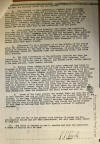
|
2.
9 April 1932.
Report on Recent Occurrences at
Kisalaya.
Col. L. L. Leech, Bluefields, to
Jefe Director GN Managua, p. 2.
" . . . Inman
that the Kisalaya patrol had not
arrived. ¶ 3. Upon receipt
of this information, Captain Inman
hurriedly took off for Kisalaya by plane
and on arrival there about 0900 found
the place deserted, the cuartel a
shambles and completely stripped of
everything except cots, and the wrecked
radio outfit. Reference (C) is a
statement of the property and funds on
hand in the cuartel at the time the
mutiny occurred. Practically
nothing has been recovered. All
ammunition, grenades, automatic weapons,
and an unknown quantity of Krag rifles
as well as all the property had been
removed. All the papers and
records were torn up and scattered over
the place. ¶ 4. Upon seeing
the place deserted, the planes saw
signaling from down the river, and on
investigating discovered Lieut. Reyes,
and evacuated him to Port, learning from
him what had happened, they returned in
the afternoon, patrolled nearly to the
Waspook seeking the escaping mutineers,
and though they saw suspicious signs,
yet no people. On their return
trip the remains of Lieut. Levonski were
evacuated to Port, and buried about 1530
April 8, 1932. ¶ 5.
Reference (b) is a statement of an eye
witness of the events after the shooting
up of the cuartel. Reference (e) is a
roster of the Guardia at Kisalaya at the
time of the occurrence. It shows
also, those who mutinied, those who
remained loyal and whereabouts known,
and those still missing. ¶
6. The last information of the mutineers
received was from the Indians on the
river who stated they had crossed into
Honduras, left their boats on the river
bank at Pranza, and headed north, having
secured a few pack animals, exact number
unknown. ¶ 7. Captain Inman
states he and the plane personnel had
lunch in Kisalaya on Monday, April 4,
1932 and had left there about 1300
arriving in Port about 1400. While
they were there, everything seemed to be
all right through he noticed Sergeant
Jimenez appeared glum. At the time
they were there, the automatics were in
the officers’ quarters where they
habitually kept except when on patrol.
The Heavy Browning was in its defensive
position in a Barbette. It has not
been learned how the Thompson Machine
Guns came to be out of the officers’
quarters unless preparations were under
way for the patrol to leave early the
next morning. The ammunition was
kept in a specially built strong room
under the floor of the barracks, and
kept securely locked. Proper care had
been taken for the security of the
weapons and ammunition. The large
amount of Springfield had been sent from
Bluefields, when the detachment was
first formed and sent up. ¶
8. Seven of the loyal Guardia who worked
their way down the river to Cabo
Gracias, are now en route here, and will
be closely examined on their arrival.
It has been definitely determined that
one Sergeant, and fourteen men composed
the group who finally entered Honduras.
It is believed that initially only a few
were disgruntled, and forced the better
element to join them by telling them
they were equally involved in anything
happened. ¶ 9. Just how far
or how general this feeling of unrest
and dissatisfaction exists has not been
ascertained, but will make every effort
to find out. ¶ 10. The Board
of Inquest is now in session and upon
its completion a Board of Inquiry will
be held. ¶ L. L. LEECH"
|
|
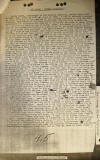
|
3.
9 April 1932.
Report on Recent Occurrences at
Kisalaya.
Col. L. L. Leech, Bluefields, to
Jefe Director GN Managua, p. 3.
[Statement of 2nd
Lt. Carlos Reyes, p. 1.]
"LT. REYES, CARLOS STATEMENT. ¶
I, Carlos Reyes, Lieutenant in the
Guardia National, hereby state that on
April 4th, 1932, at 4:00 pm. more or
less, I and Lt. Levonski disposed to
issue clothing to the members of the
guardia detached at this barrack,
Kisalaya, Department of Northern
Bluefields, and for this ordered the
detachment for formation and started to
issue for the more in need, taking in
consideration what we had in stock.
After, continued issuing to the rest of
the members an article a piece so as to
get everybody supplied. But among
these last guardias, the Raso Salmeron,
Pablo P. #2970 emerged saying that he
had already been long in the guardia and
yet he had only received a suit and that
in that case, it should be rather better
they would not give him even [suit]
stepping out the formation and going to
sit on the barrack steps by the side of
Sgt. Jimenez. Then Lt. Levonski on
hearing those remarks of Salmeron,
offered this man to be put in jail, then
all the members of the company looked
each other and Lt. Levonski ordered the
Cabo de Guardia again but he also was
disobeyed, then addressing to Sgt.
Jimenez, said “Well, Sgt. What do you
wait?” to which he answered “that all
what Raso Salmeron had said was
correct”. Then I going down the
office steps ordered to the Sgt. and
Raso Salmeron to pass to the brigs to
which Sgt. Jimenez answered, “I’m going
to get ready” getting up from the steps
and going in where he had his cot and
coming out right after holding a gun
machine, Sub Thompson, also calling to
the company to get their rifles. I
went back in the office and turned
toward the right and held Lt. Johnson
rifle, loading it and taking position of
defense. Then, in that moment, the
company in choir yelled “to the trenches
boys’ which are 20 yds. of distance to
the office. Lt. Levonski held his
pistol 45 started speaking to the
company, that they would not do that and
addressing to the Sgt. told him “Lay
that off. Sgt. What are you going to for
goodness sake, I beg you,” to which he
answered, “Lieutenant Reyes come out and
we won’t do any harm” without referring
to whom these words were meant to.
Then Lt. Levonski forwarded to the gun
machine, Browning, which we had in the
office and still on begging, didn’t want
to fire with the machines, but they from
the trenches broke fire against
ourselves, to which fire I was wounded
on my right side and fired several shots
with the rifle, so, I am certain Sgt.
Jimenez was wounded in a leg but don’t
know which one. The fire was so heavy
maintained with 2 Thompson machines, 1
Browning rifle and Krag rifles. I
then observed that Lt. Levonski did not
fire, disposed to go close to him and
examined him under a table, and saw him
bended on the machine, inactive and
smeared with blood, for which I realized
was dead. When I saw that, noticed
that they got close to ourselves, and
determined to escape toward several
burnt houses which are located about 500
yds. of distance from there where I
could hide and in the meantime I ran,
heard they said “there he goes,
scoundrel, shoot him” and heard several
shot sounds for which I could detect
they were machine and rifles, and so
they still wounded me again in my left
arm. Once in my hidden place,
heard the noise they made when looking
for me with much earnest, without
finding me, so they determined to press
the fire all over the area.
Besides being in my hidden place could
detect that they went on drinking at Mr.
Abraham Martinez commissary, which it
had recently been established up there.
Instants after, heard that they took a
schooner and having all women and
children go aboard they cleared bound
Mocarina. After they have gone, I
came out my hidden place and walked,
always holding my rifle. I
determined to go and see Lt. Levonski,
so, reached the office, took a package
of matches out of my pockets and placed
me by a table and took two sticks and
put them between my teeth and scratched
it with my right hand and examined Lt.
Levonski and recognized that he was
absolutely dead. This was at 7:00
pm more or less. After I . . . "
|
|
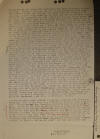
|
4.
9 April 1932.
Report on Recent Occurrences at
Kisalaya.
Col. L. L. Leech, Bluefields, to
Jefe Director GN Managua, p. 4.
[Statement of 2nd
Lt. Carlos Reyes, p. 2.]
" . . . looked around and found that
everything had been destroyed, robbed
and lost. After I went out the
office and walked toward a camp tent
where I found two pillows, one sheet
etc., and determined to lay down.
As the wound caused me so much pain and
was bleeding constantly it was
impossible to fall asleep for me, and it
was about 9:30 pm. when I detected there
was somebody lighting with flash light
at the commissary and wishing to inquire
who mere, got up and went by the office
up to 12 yards from the place and
noticed that they were robbing and heard
someone say “There is beer here, who
wants one?” and to these words could
detect the Raso Pantoja, Juan R. #1443
was one of them, another was Rafael
Bucardo #3183 and two more who could not
distinguish or identify. When I
recognized my imprudence, I returned and
did hide on back the toilet.
Moments later, they went in the office
and went in the barrack and went to my
tent, and once there when finding blood
smears said “look, Lt. has been here, so
he isn’t dead,” and went up on walking
to the kitchen, and after they returned
and went to the river shore and took a
boat again bound to Macarina. Spent the
night in a little house out there, and
went the following day in the morning on
a trail to Waspan, this was on Tuesday.
Once there, the Indians made me the
first care, moments later the Alcalde of
Saupuka arrived to whom gave order to me
to Kisalaya to pick up Lt. Levonski body
and all the guardia articles.
About 2:00 pm. the Alcalde advised me to
move to the other side, being there
safer, so I did, ordering him to
organize a civil guardia to protect him,
and for that purpose I gave him my
pistol and to another indian of his own
trust gave my rifle. About 4:30
pm. the Alcalde returned with Lt.
Levonski corpse, bringing lard, beans
and rise left up there, to determine to
cook some food for the people who were
guarding by. Spent there the
night, and there were also many rumors
that they were coming back, but
nevertheless they didn’t show up.
Next day, Wednesday, about 8:00 am
determined to bury Lt. Levonski corpse
for I didn’t see any airplane coming nor
patrol appearing coming from port, but
about ½ hour later when I was getting
ready to go to Camp Gracias, together
with the Alcalde and the guards, heard
the airplanes coming, run to the river
shore and ordered that the people should
not move and proceeded to unfold a sheet
on the ground and making an R. my second
name initial with the second and placing
me in the center by the side, so as to
get the aviators recognize me, as they
did. So after they landed they
pick me up and brought me over into
port. Before finishing my narration
state that the company behavior with
exception of CH Tercero, Cabo, who me I
saw and several others whom was told
about, was aggressive, for Tercero is
the only one whom I personally saw going
out the office with no rifle nor
equipment, and in a way of running
about. ¶ As antecedents to
this infaust happening, remember that
about two weeks ago, just at the time
when forming for routine work, someone
said “do not go out for formation, let
them come to make us to”, this, adding
to the fact of selling beer up there and
to a rumor which came to me through a
mosquita, assured that they had already
planned for this deed and those purposes
were to kill the three American officers
and after, join to the outlaws, which
all these facts made to judge that there
was ill preparation against the officers
in this detachment. For my part I
remember I in certain occasion told Lt.
Levonski that the selling of beer might
be unadvisable, to which he smiled and
didn’t get any answer from him. ¶
Carlos Reyes ¶ 2nd. Lt.
G.N."
|
|
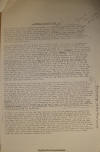
|
5.
9 April 1932.
Report on Recent Occurrences at
Kisalaya.
Col. L. L. Leech, Bluefields, to
Jefe Director GN Managua, p. 5.
[Statement of
Juanita Castillo, p. 1.]
"STATEMENT OF JUANITA CASTILLO ¶
I was in my house when I heard Lt.
Levonski say “No, Sergeant, don’t fire
that gun.” All Guardia were in the
trenches and the Sergeant was standing
on the ground in front of the office
building. Lt. Levonski was
standing in the doorway. When the
Sergeant turned the gun loose on Lt.
Levonski I immediately left and took
refuge in the General Moss building.
As I got there I saw Lt. Reyes running
from the scene toward the cantina of
Adrian Martinez and saw Guardia in the
trenches shooting toward the office
building. Raso Pantoja was patrolling
around office with an automatic shooting
toward Lt. Reyes. ¶ I then
left Kisalaya for the jungle with a
little girl. Ahead of me I saw
Green and Blandon. Half an hour
later I went back to see if they had
killed Lt. Reyes. The Guardia
called me and told me to hurry up at the
same time calling me a low down woman.
I was forced to join them. As I joined
the mutineers Vivian Hernandez had an
automatic and said “See, I am going to
kill you, puta.” Sergeant Jimenez
told Hernandez “No don’t shoot her,
wait.” “But listen here, puta, you
are going with me.” I told him
that I was going but I needed some
clothes and blankets and the Sergeant
said to me “Alright go and get your
damned clothes.” When I got to my
house, escorted by a sentry named
Frederico Flores he took all Lt. Reyes
equipment and said “Now get mad, puta, I
am going to wear your man’s clothes.”
(Reyes) Then he escorted me to the
mutineers and the Sergeant ordered me to
go aboard the gasoline boat of Abram
Martinez. I did not go aboard as I
needed another dress I had left in the
house. The Sergeant sent me to get
it with another Guardia (Salmeron).
As I got into the house I found F.
Flores trying Lt. Reyes’s clothes on and
he said “Are you sore at me?” Salmeron
and I left the house for the boat,
leaving Flores in the house. When
I boarded the gasoline boat Mr. Martinez
and brother were there and several
pitpans loaded with Moskito women.
In two empty boats they put all
ammunition and the heavy Browning in the
gasoline boat. The Sergeant told
all the women to go and if they saw any
Guardia come up river, tell them that
you don’t know anything about this.
¶ They started the motor and
started up river with two boats
trailing. While going up river
Guardias were throwing grenades and
firing. A few Guardias were
walking up along the beach also firing
and throwing grenades. The
Guardias kept on asking me where Lt.
Reyes was hiding and insulting me
terribly. The Sergeant fired three
discs of ammunition towards the edge of
the river, shells falling at my feet.
The Guardias walking on the beach came
aboard. We kept on going at night
until the boat struck shallow water.
Mrs. Martinez informed the Sergeant that
he couldn’t go any further. He
told Mr. Martinez and brother that they
were not going to kill them. They
then jumped off the boat and got to the
beach. Then all opened fire at
them in the darkness. This
happened at Mocorin. We all
disembarked here and the Sergeant
suggested to the others that it was safe
to go back to Kisalaya to get something
to eat and take all the provisions.
Cabo Medina and A. Alvares got aboard on
one of the small boats to guard
ammunition and five men boarded the
other pitpan to get provisions.
These men were Pantoja, Balles, Bucardo,
Julio Salazar, Lopez and Castellon.
¶ We were on the beach waiting and
they took much time and the Sergeant was
nervous and in pain. He ordered a
native woman of Mocorin to make some hot
water for his leg. He ordered
Taylor and Hernandez to go and get men
(civilians) to paddle canoes with orders
if they refused to shoot them, they got
four men and two women. When the
provision boat came they left the
gasoline boat there and proceeded up
river. All night we travelled till
at Saulalla we encountered about eight
boats coming down river and the Sergeant
ordered them to go back, they could not
pass. The Sergeant asked them
where Laimus was but did not proceed
because it was daylight and said he was
afraid of two planes. We stayed in
Saulalla till 3 pm. Tuesday. Upon
arrival in Saulalla 5 a.m. they took
everything out of the boats and put it
on the banks of river and covered it
with branches of trees. They
pulled boats ashore and turned them over
on the beach, we got under cover of
trees and selected clothes they stole. .
. . "
|
|
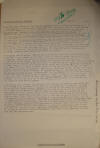
|
6.
9 April 1932.
Report on Recent Occurrences at
Kisalaya.
Col. L. L. Leech, Bluefields, to
Jefe Director GN Managua, p. 6.
[Statement of
Juanita Castillo, p. 2.] " .
. . ¶ While they were talking and
treating the Sergeant’s leg and fixing
the machine gun I heard them say it was
no good. They threw their
Nicaraguan insignia, issued clothes to
the three prisoners they had in Kisalaya
and said they intended to mutiny about
two months ago. Sergeant said he
was sure that only one Macho was killed,
they tried to kill all of them,
especially Lt. Levonski because he
worked them too much, sometimes they did
not have enough time to eat, that they
had to go back to work. They were
going to do this drunk or sober.
They did not like that life taking
orders and being abused by the Macho and
that they wanted to talk to the Jefe of
the bandits and join them. Balles said
to the Sergeant “Let’s go to Honduras”.
Sergeant said “No, it is bad for us at
this time in Honduras, Capt. Inman could
send a radio to Honduras to arrest us
and lose our life, it is best to join
the bandits only for about three months,
within this time they will cool off
about Lt. Levonski’s affair and then we
can go to Honduras.” Balles did
not agree to go with the bandits.
“Neither do I” said Jose. Salmeron
said “You two had better come along.”
¶ The Sergeant went to sleep.
When he got up I told him I wanted to go
home and he kept saying “No.” I was
trying all the time. About 11
o’clock Tuesday morning he said that I
could go. While I was getting my
things together he changed his mind and
said that I could not go until 5 p.m.
All the Guardia were laughing and said
“When you pass by Kisalaya tell Lt.
Levonski to give you a pass so that you
can go ahead.” “When you get to
Puerto Cabezas give my best regards to
Lt. Reyes” said Estrada. Salmeron
said “Tell Capt. Inman that I am coming
to Puerto Cabezas to let him take
another $10, or mine.” “Pentoja sends
regards to Apendano.” The Sergeant
advised me to tell nothing about the
affair to anybody in Puerto Cabezas.
If Capt. Inman asks you anything tell
him that we will be back the 15th of
May. Castellon said “No, no, Sergeant it
is better the first of May” “No” said
the Sergeant “it is better the 15th” We
are good men and we have enough good
arms.” All the men then said “Viva
al Sergento.” They then fixed
rifle grenades. The heavy Browning
was no good and they said to throw it in
the river for they could not carry
excess baggage. ¶ I was
waiting for a pitpan. The Sergeant
said “When you get where my woman lives
tell her to notify me by an Indian if
Lt. Peterson and Guardia are in
Kisalaya. My woman can get you
into Puerto Cabezas. Estrada said
for us to tell everybody of authority
that I went into the Savannahs when the
shooting took place and that I do not
know a thing about it. About 3
p.m. a Moskito woman came down river in
a pitpan and the Sergeant told her she
could not pass, she said that she did
not want to pass by Kisalaya at night.
Then I asked him if I could go with her,
he gave me $5.00 to buy myself something
to eat, I got into the Moskito’s boat
and started down river. At 8 or 9
o’clock we arrived at Kisalaya. Below us
many fires on the beach, Indians were
cooking about 1000 yards below Kisalaya
and here I found Lt. Reyes wounded on
the chest and arm. I told Lt.
Reyes to go to Cabo Gracias. Then
Lt. Reyes showed me the body of Lt.
Levonski who was taken from Kisalaya by
Indians by order to Lt. Reyes and he
gave orders to Indians to make a box for
Lt. Levonski, purchased 30 cents worth
of nails and buried him across the river
on the Kisalaya side about 8 a.m.
Wednesday and about 9:30 a.m. the
aeroplanes came."
|
|
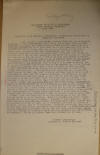
|
7.
9 April 1932.
Report on Recent Occurrences at
Kisalaya.
Col. L. L. Leech, Bluefields, to
Jefe Director GN Managua, p. 7.
"DEPARTMENT OF NORTHERN BLUEFIELDS
¶ PUERTO CABEZAS, NICARAGUA
¶ 9 April 1932 ¶
STATEMENT OF EDWARD J. SUPRENANT
CONCERNING THE MUTINY OF KISALAYA,
NICARAGUA ¶ I, Lt. Edward J.
Suprenant, Guardia Nacional, while
District Commander of Moss Commandancia
on or about the 4 April 1932, at 0300
received a telephone call from Louisiana
Farm and upon answering it a Cabo Jose
Tercero ask me to come there as he had
something very important to tell me.
As I know this man was the corpsman at
Kisalaya I immediately proceeded from
Moss Commandancia and upon arriving at
Louisiana Farm met this man. He
became very irrational upon seeing me
and I ask him to tell me about it and so
he said that Monday afternoon two
guardia were fighting over 3 pair of
pants in front of the cuartel at
Kisalaya. After a while one of the
men ran into the barracks and came back
with a sub Thompson. Upon seeing
this he knew something was wrong and
immediately ran to the rear of the
cuartel. As he was running he
heard Lt. Levonski yell, then a burst of
shots. He then ran down towards
the river and as he was running he said
that it seem all the guardia were
shooting, rifle grenades were going off
and in general an awful uproar. He
then jump into a pitpan and went down to
Saupuga and from there he came into the
lines of Louisiana and called me up.
The above information was all jumble up
and I had to have the man repeat and
repeat. He was about half crazy
and would stop in a middle of a sentence
to beg me not to kill him. I
assured him each time that not to worry.
I then left Louisiana Farm and went back
to Moss Commandancia where I told the
Sergeant of the Guardia to put him in
the cuartel. He then began to
scream and beg me not to kill him and
beg the guardia not to let me kill him.
I felt rather sorry for him and told the
guardia to put him in my room where he
would be alone and could rest. I
then cleared that Commandancia for
Vaccaro Commissary where I could call up
Puerto Cabezas over the phone privately.
I call up Captain Inman at about 2340, 4
April 1932 and inform him of all that
had happen so far. He then give me
orders to go to Cuyutigne where Lt.
Peterson was with a patrol waiting for
Lt Reyes from Kisalaya. I cleared
at about 0800, 9, April 1932, from Moss
Commandancia arrived at Logtown about
0100. Cleared here and arrived
Cuyutigne at 0500, met Lt. Peterson and
found out patrol of Lt. Reyes had not
come in at Cuyutigne. Returned and
called from Louisiana Farm this
information. Arrived at Louisiana
Farm at 0600. Upon arriving at
Moss Commandancia guard informed me that
this guardia Jose Tercero had climbed
through the read door which was not
completed and had no stairs had escaped.
I called up Captain Inman and informed
him of this. ¶ Edward J.
Suprenant ¶ Lieutenant,
Guardia Nacional"
|
|
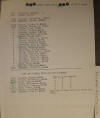
|
8.
9 April 1932.
Report on Recent Occurrences at
Kisalaya.
Col. L. L. Leech, Bluefields, to
Jefe Director GN Managua, p. 8.
"GUARDIA THAT
WERE AT KISALAYA ON THE 4 APRIL 1932.
¶ Lt. Levonski, Charles J. ¶
Lt. Reyes, Carlos ¶ Sgt.
Jimenez, Sebastian, #3427 ¶
Cabo Blandon, Simeon, #3422 ¶
Cabo Medina, Carlos S. #4848 ¶
Raso Alvarez, Antonio O. #4812 ¶
Raso Balles, Jose, #3421 ¶
Raso Bricano, Felipe #4763 ¶
Raso Bucardo, Rafael V. #3183 ¶
Raso Castellon, Francisco #3191 ¶
Raso DeVia, Thomas #3027 ¶
Raso Estrada, Alejo G., #4643 ¶
Raso Florez, Aurelio #4729 ¶
Raso Flores, Federico #2828 ¶ Raso
Gonzales, Jose A. #4594 ¶
Raso Green, William B., #4766 ¶
Raso Gudiel, Santiago #3217 ¶
Raso Hernandez, Vivian #3004 ¶
Raso Lopez, Francisco S., #4637 ¶
Raso Osorio, Carlos C. #4629 ¶
Raso Pantoja, Juan R. #1443 ¶
Raso Salazar, Julio R., #4653 ¶
Raso Salmeron, Pablo F. #2970 ¶
Raso Sequeira, Jose M., #4759 ¶
Raso Shaw, Frank #3324 ¶
Raso Taylor, Garfield #4479 ¶
Cabo Tercero, Jose T., #2660 ¶
LIST OF GUARDIA THAT DID NOT DESERTED
¶ Cabo Blandon, Simeon #3422 now
at Cabo Gracias ¶ Cabo
Medina, Carlos S. #4848 now at Cabo
Gracias ¶ Raso Davis, Thomas
#3027 now at Cabo Gracias ¶
Raso Green, William R., #4766 now at
Cabo Gracias ¶ Cabo
Sequeira, Jose M., #4759 now at Cabo
Gracias ¶ Cabo Shaw, Frank
#3324 now at Cabo Gracias ¶
Cabo Taylor, Garfield #3379 now at Cabo
Gracias ¶ Cabo Tercero, Jose
T. #2660 reported at Moss Farm but later
run away."
|
|
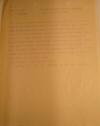
|
10 April
1932.
Radiogram from
Philip, Puerto Cabezas, to
Comsperon.
"ALL QUIET PUERTO
CABEZAS AREA. ONE SERGEANT AND 14
IN GUARDIA DESERTED TO HONDURAS WITH
ABOUT 3 AUTOMATIC WEAPONS 12 RIFLES AND
15000 ROUNDS AMMUNITION. POST AT
KISALAYA REESTABLISHED REDUCED
COMPLEMENT BEING REENFORCED, MORALE
GUARDIA AFFECTED SOMEWHAT BUT SITUATION
IN HAND. COMMANDER NORTHERN DISTRICT OF
BLUEFIELDS ON GROUND CONDUCT BOARD
INQUEST COURT INQUIRY AND REMAIN PUERTO
CABEZAS UNTIL ABOUT 15 APRIL.
POSSIBLE BANDIT ACTIVITIES ANTICIPATED
IN ABOUT TWO WEEKS. FURTHER STAY NOT
CONSIDERED NECESSARY AT THIS TIME.
UNLESS DIRECTED OTHERWISE WILL DEPART
TOMORROW MONDAY ARRIVE CRISTOBAL ABOUT
1600 22 APRIL. . . . "
|
|
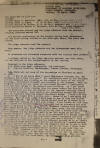
|
1.
11 April 1932.
Court Inquiry into the Mutiny at
Kisalaya before
Capt. Harry J. Scholtes, Capt. Orrel A.
Inman, Capt. William W. Davies, 1st Lt.
Robert L. Peterson, Judge Advocate, Puerto
Cabezas, p. 1.
"The court met at
1:15 p.m. Present: Captain Harry J.
Scholtes, (MC), G.N. de Nic., (Lieut.
(CC), U.S.N.), Captain Orrel A. Inman,
G.N. de Nic., and (Captain, U.S.M.C.),
Captain William W. Davies, G.N. de Nic.,
members; and (1st-Lt. USMC), First
Lieutenant Robert L. Peterson, G.N. de
Nic., judge advocate. (2nd Lieut. USMC)
¶ The court was cleared and the
judge advocate read the precept,
original prefixed marked “A”. ¶
All matters preliminary to the inquiry
having been determined, and the court
having decided to sit with open doors,
the court was opened. ¶ The
judge advocate read the precept. ¶
Each member, the judge advocate and the
interpreter were duly sworn. ¶
No witnesses not otherwise connected
with the inquiry were present. ¶
A witness called by the judge advocate
entered, was duly sworn, and was
informed of the subject matter of the
inquiry. ¶ Examined by the
judge advocate 1.Q, State your name,
occupation, and residence. A.
Juanita Castillo, housekeeper, Puerto
Cabezas, Nicaragua. ¶ 2.Q.
State all you know of the happenings at
Kisalaya on April 4, 1932. ¶
A. I was in my house when I heard
Lieutenant Levonski say, “No Sergeant,
don’t fire that gun.” All the
Guardia were in the trenches and the
Sergeant was standing on the ground in
front of the office building.
Lieutenant Levonski was standing in the
doorway. When the Sergeant turned
his gun loose on Lieutenant Levonski I
immediately left and took refuge in the
general mess building. As I got
there I saw Lieutenant Reyes running
from the scene toward the cantina of
Adrien Martinez and saw the Guardia in
the trenches shooting toward the office
building. Raso Pantoja was
patrolling around the office with an
automatic shooting toward Lieutenant
Reyes. I then left Kisalaya to the
jungle with a little girl. ahead of me I
saw Green and Blandon. Half an
hour later I went back to see if they
had killed Lieutenant Reyes. The
Guardia called me and told me to hurry
up, at the same time calling me a low
down woman. I was forced to join
them, as I joined the mutineers Vivian
Hernandez had an automatic and said
“See, I am going to kill you, puta.”
Sergeant Jimenez told Hernandez “No,
don’t shoot her, wait” but listen here,
puta, you are going with us.” I
told him that I was going but that I
needed some clothes and blankets and the
Sergeant said to me “All right go get
your damned clothes.” When I got
to my house escorted by a sentry named
Frederico Flores he took all Lieutenant
Reyes’ equipment and said “Now get mad,
puta, I am going to wear your man’s
clothes.” Then he escorted me to
the mutineers and the Sergeant ordered
me to go aboard the boat of Abram
Martinez. I did not go aboard as I
needed another dress I had left in the
house and the Sergeant sent me to get it
with another Guardia named Salmeron.
As I got to the house I found Frederico
Flores trying Lieutenant Reyes’ clothes
on and said “Are you sore at me?”
Salmeron and I left the house for the
boat, leaving Flores in the house.
In two empty boats they put all the
ammunition and in the gasoline boat they
put the heavy Browning. They
started up the river with the three
boats, the Guardia throwing grenades . .
. "
|
|
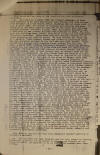
|
2. 11 April 1932.
Court Inquiry into the Mutiny at
Kisalaya before
Capt. Harry J. Scholtes, Capt. Orrel A.
Inman, Capt. William W. Davies, 1st Lt.
Robert L. Peterson, Judge
Advocate, Puerto Cabezas, p. 2.
[p. 13 in
original pagination; pages 2-12 not
included here.] " .
. . 2. Q. State all you know of the
death of the late Lieutenant Levonski.
¶ A. At 1:00 a.m. 6 April 1932 the
outpost commander at Moss Farm reported
to me that Practicante Jose Tercero had
just arrived from Kisalaya in a bad
mental state, claiming that at about
4:30 p.m. 4 April 1932, the troops at
Kisalaya had mutinied and were shooting
up the post, that he had left at the
first shot and knew nothing further.
At 0800, 6 April 1932, Lieutenant
Cipolloni and I left Port in two planes,
arrived over Kisalaya at 0900. The
outpost and building were intact, flag
still flying but was apparently
absolutely deserted. Drops were made and
repeated efforts to attract attention
met with no avail. We then scouted
the river and at a sandbar, Ulwas
Dakura, landed and picked up Lieutenant
Reyes who was seriously wounded in the
left arm and right breast. Reyes
stated that Jimenez with fourteen other
Guardia had mutinied, at 1630 4 April
1932, killing Lieutenant Levonski,
seriously wounding himself and had taken
off up river with all arms and
ammunition in the post. He also
stated that several faithful Guardia had
broken away and headed, some to Cabo
Gracias and, he thought some for the
line over the savannahs. He also
stated that the remains of Lieutenant
Levonski had been brought down river by
Indians at his orders, and had been
buried on the bank of the river at
Waspan about 0800 that same norming.
We rushed Reyes to the Guardia Hospital
in Puerto Cabezas, en route picking up a
patrol under Lieutenant Peterson of
twelve Guardia at Cuy Tigne, dropped
orders to Lieutenant Peterson to proceed
at once to Kisalaya and hold the post
until further orders. A report of
what was then known was dropped to him
with the message. At 1730 the
planes were again dispatched up the Coco
River in an attempt to locate and if
possible destroy the mutineers and, or
then, return to pick up remains of
Lieutenant Levonski which had been
ordered exhumed by myself earlier in the
morning and returned with them to Puerto
Cabezas. The remains were buried
in Guardia Cemetery, Puerto Cabezas at
1500, 8 April 1932, by order of the Jefe
Director. In the morning of 7
April about 0900, I arrived by airplane
at Kisalaya, found patrol under
Lieutenant Peterson had already taken
over command of post. Inspection
of the post disclosed that the mutineers
had taken all arms and ammunition as per
list appended marked “B”. The
radio set had been completely demolished
and all effects and records of
Lieutenant Levonski’s had been destroyed
or scattered throughout the post.
The names of men who broke away and
reported in to Cabo Gracias as per list
appended marked “C”. Rasos
Frederico Flores and Antonio Alverez
returned part way to Cabo Gracias but
through fear changed their minds and
went to Honduras. The men who
accompanied the mutineers are as per
list appended marked “D”. The
complement of the post at the time of
mutiny was one First Lieutenant Charles
J. Levonski, one Second Lieutenant
Carlos Reyes, one radio operator, and
twenty-three enlisted men.
Lieutenant Levonski took command by my
orders on 1 March 1932. The time
Lieutenant Levonski took over command
while not low, the morale could not be
considered as excellent. During
the month and four days in which he
commanded I have made five weekly
inspections of Kisalaya, each inspection
showed a remarkable improvement in
conditions of buildings, grounds, and
especially the morale of the men.
He had established regular routine with
numerous games, interspersed between
working and drill periods which pleased
the men very much. The sudden turn
of the command in this mutiny is
unexplainable as on the morning of 4
April I inspected the post and paid the
command, leaving there at 1500 by
airplane. The command was in
excellent shape, cheerful and apparently
thoroughly contented. ¶ 3.
Q. What do you mean by “not very
excellent morale” previous to Levonski’s
arrival? ¶ A. The men were
not very cheerful and not very prompt in
obeying orders but questions put by
myself to various men brought out no
cause for this. It appeared to me
as though the command were stagnating. .
. . "
|
|
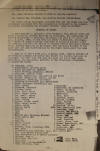
|
3.
11 April 1932.
Court Inquiry into the Mutiny at
Kisalaya before
Capt. Harry J. Scholtes, Capt. Orrel A.
Inman, Capt. William W. Davies, 1st Lt.
Robert L. Peterson, Judge
Advocate, Puerto Cabezas, p. 3.
[p. 15 in
original pagination; page 14 not
included here.] " . . .
Neither the court, the judge advocate
nor any party of the inquiry desired any
more witnesses. ¶ The judge
advocate desired to make no opening
argument. ¶ The inquiry was
finished, all parties thereto
withdrawing. ¶ The court
having thoroughly inquired into all the
facts and circumstances connected with
the allegations contained in the
precept, and having considered the
evidence adduced, finds as follows:
¶ FINDING OF FACTS. ¶
1. That Charles J. Levonski, late
sergeant, U.S. Marine Corps and first
lieutenant, Guardia Nacional de
Nicaragua, was commanding the Guardia
Detachment at Kisalaya, Nicaragua and
that at or about 4:30 p.m., 4 April,
1932, he did meet his death at Kisalaya,
Nicaragua, as a result of gunshot wounds
inflicted by mutinous guardia under his
command, and that his second in command
Second Lieutenant Carlos Reyes, Guardia
Nacional de Nicaragua, was seriously
wounded in the upper left arm and
superficially in the right chest, under
the same circumstances. ¶ 2.
That at or about 4:30 p.m., 4 April,
1932, certain members of the Kisalaya
command did mutiny and desert the
Guardia Nacional de Nicaragua, and that
they did loot the post and carry away
arms, ammunition, and equipment,
property of the Nicaraguan Government,
as enumerated below: ¶ 25
Grenades, rifle; 2 Dischargers, grenade
rifle; 1 Rifle Springfield, #327131; 1
Rifle Browning Automatic, #65105; 4
Carriers, grenade rifle; 10192 Rounds,
ammunition, Springfield cal 30-50; 1987
Rounds, ammunition, pistol, cal 45; 20
Magazines, Browning, automatic; 3
Thompson Sub-machine guns #5219-5029; 6
Drums, Thompson Sub-machine gun; 1 Belt,
pistol; 4 Lanterns, kerosene; 1 Pitcher,
agate; 2 Pens, dish, metal; 2 Pots,
large, agate; 1 Pot, small, agate; 1
Tub, large, metal; 2 Pans, frying; 5
Spoons, large, metal; 1 Fork, large,
metal; 1 Ladle, agate; 2 Basins, agate;
3 Shovels; 1 Pick; 2 Axes; 1 Machine
gun, Browning #146849; 1 Cover barrel
BMG; 3 Buckets; 3 Padlocks; 14 Chain,
inches; 100 Rope, feet; 3 Pouches, drum,
magazine, STEG; 1 Saw, hand; 1
Transmitter and receiver, type, BC-7
serial #27; 1 Box, type DC-102 serial
#248; 1 Bag, equipment and 2 cranks
complete; 1 Battery, type B; 3
Batteries, dry cell; 1 Kit, tool; 1
Regulator, voltage M-MC-52; 1 Tape,
friction, roll; 4 Machetes; 6 Machetes,
w/scabbards; 6 boxes, clothing; 1
Hammer, carpenter; 1 Whetstone; 1 File,
flat; 2 Drivers, screw; 2 Knives,
butcher; 2 Bags, canvas; 1 Saddle, pack;
10 Capotes, de uli; 4668 Krag ammunition
1898; 9 Grenades, hand; 1 Tripod, BMG
#55114; 1 Barrel, extra, BMG; 1 Cover,
BMG; 1 Flag, national; 2 rods, cleaning;
2 Panel, plane, sets; 6 Boxes,
ammunition, BMG; 1 Can, water, BMG; 1
Condenser, BMG; 1 Package, parts, rifle;
3 Tubes radio WX12; 4 Tubes radio UX210.
. . . "
|
|
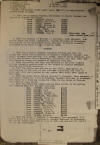
|
4.
11 April 1932.
Court Inquiry into the Mutiny at
Kisalaya before
Capt. Harry J. Scholtes, Capt. Orrel A.
Inman, Capt. William W. Davies, 1st Lt.
Robert L. Peterson, Judge
Advocate, Puerto Cabezas, p. 4.
[p. 16 in
original pagination.] ".
. . 1 Scarf, field; 6 Trousers, khaki; 6
Undershirts; 4 Hats, field; [?], khaki;
6 Drawers, knee; 12 Hoes, native ¶
Thirty one dollars sixty seven cents
($31.67) in each, Quartermaster funds on
hand. ¶ 3. That the
following Guardia did return to Puerto
Cabezas and report to Guardia officials:
¶ Cabo BLANDON, Simson #3422; Cabo
MEDINA, Carlos S. #4848; Raso DAVIS,
Thomas #3027; Raso GREEN, William R.
#4766; Raso SEQUEIRA, Jose M. #4759;
Raso SHAW, Frank #3324; Raso TAYLOR,
Garfield #3379; Cabo TERCERO, Jose T.
#2660 (Reported; ran away crazed from
Moss) ¶ 4. That the remains
of Charles J. Levonski, late sergeant,
U.S. Marine Corps and first lieutenant,
Guardia Nacional de Nicaragua, were
buried in the Guardia Nacional cemetery
in Puerto Cabezas, Nicaragua at or about
3 p.m., 8 April, 1932. ¶
OPINION ¶ 1. That the
mutinous Gardia numbered fifteen and
that the munity was under the leadership
of Sergeant Sebastian Jimenez, G.N.
#3427 , Private Juan Pantoja, G.N.
#1443, Private Pablo Salmeron, G.N.
#2970, and Private Vivian Hernandez,
G.N. #3004, and that there had been
drinking among the Guardia at Kisalaya
that day. ¶ 2. That the
mutiny had been premeditated by the four
leaders and was directly precipitated by
the orders to confine Sergeant Jimenez
and Private Salmeron. ¶ 3.
That the mutiny was not due to any
fault, negligence, or inefficiency on
the part of the officers concerned, and
that it could not have been averted by
any action they would have taken at that
time. ¶ 4. That the shots
which killed Charles J. Levonski, late
Sergeant U.S. Marine Corps and first
lieutenant, Guardia Nacional de
Nicaragua were fired by a Browning
automatic rifle in the hands of Private
Juan Pantoja, G.N. #1443. ¶
5. That the following named Guardia were
active in the mutiny and deserted from
the Guardia Nacional: ¶ Sgt.
JIMENEZ, Sebastian #3427; Raso BALLES,
Jose #3421, Raso BRICENO, Felipe #4763,
Raso BUCARDO, Rafael V. #3183, Raso
CASTELLON, Francisco #3191; RASO
ESTRADA, Alejo G. #4543, Raso GONZALES,
Jose A. #4594, Raso GUDIEL, Santiago
#3217, Raso HERNANDEZ, Vivian #3004,
Raso LOPEZ, Francisco S. #4657, Raso
OSORIO, Carlos C. #4629, Raso PANTOJA,
Juan R. #1443, Raso SALAZAR, Julio, R.
#4653, Raso SALMERON, Pablo P. #2970,
Raso FLOREZ, Aurelio #4729 ¶
6. That the death of Charles J.
Levonski, late sergeant, U.S. Marine
Corps and first lieutenant, Guardia
Nacional de Nicaragua, was due to wounds
received in line of duty and was not the
result of his own misconduct. . . . "
|
|
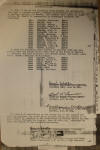
|
5.
11 April 1932.
Court Inquiry into the Mutiny at
Kisalaya before
Capt. Harry J. Scholtes, Capt. Orrel A.
Inman, Capt. William W. Davies, 1st Lt.
Robert L. Peterson, Judge
Advocate, Puerto Cabezas, p. 5.
" . . .
RECOMMENDATIONS ¶ 1. That if
any of the following named Guardia are
apprehended that they be brought before
a General Court-Martial and tried for:
I- Making a mutiny, II- Murder, III-
Assault with intent to commit murder,
IV- Theft, V- Destruction of Government
property, VI- Desertion: ¶
Sgt. JIMENEZ, Sebastian #3427; Raso
BALLES, Jose #3421, Raso BRICENO, Felipe
#4763, Raso BUCARDO, Rafael V. #3183,
Raso CASTELLON, Francisco #3191; Raso
ESTRADA, Alejo G. #4543, Raso GONZALES,
Jose A. #4594, Raso GUDIEL, Santiago
#3217, Raso HERNANDEZ, Vivian #3004,
Raso LOPEZ, Francisco S. #4657, Raso
OSORIO, Carlos C. #4629, Raso PANTOJA,
Juan R. #1443, Raso SALAZAR, Julio, R.
#4653, Raso SALMERON, Pablo P. #2970,
Raso FLOREZ, Aurelio #472 ¶
2. That the following named Guardia be
absolved from any connection with the
mutiny which culminated in the death of
Charles J. Levonski, the late sergeant,
U.S. Marine Corps, and first lieutenant,
Guardia Nacional de Nicaragua: ¶
Cabo BLANDON, Simeon #3422, Cabo MEDINA,
Carlos S. #4848, Raso DAVIS, Thomas
#3027, Raso GREEN, William R. #4766,
Raso SEQUEIRA, Jose M. #4759, Raso SHAW,
Frank #3324, Raso Taylor, Garfield #4479
¶ Harry J. Scholtes, (Lieut/MC)
USN ¶ Captain, (MC), G.N. de
Nic. ¶ Orrel A. Inman,
Captain, USMC. ¶ Captain,
G.N. de Nic. ¶ William W.
Davies, 1st Lieut. USMC ¶
Captain, G.N. de Nic. ¶ The
record of proceedings of the second day
of the inquiry was read and approved,
the court being cleared during the
reading of so much thereof as pertains
to the proceeding in cleared court, and
the court having finished the inquiry,
then at 4:00 p.m., adjourned to await
the action of the convening authority.
¶ Barry J. Scholtes, Lieutenant
(MC), U.S. Navy. ¶ Captain,
(MC), G.N. de Nic., President ¶
Robert L. Peterson , 2nd Lieut. U.S.
Marine Corps. ¶ First
Lieutenant, G.N. de Nic., Judge
Advocate."
|
|
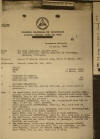
|
1.
11 April 1932.
Record of Events, Eastern Area, Month of
March 1932, Acting Area Commander
Capt. M. Cox,
Bluefields, to Jefe Director GN Managua,
p. 1.
"Reference:
General Order No. 140, 1929. ¶
A. PERIOD FROM: 1 March, 1932. TO: 31
March, 1932. ¶ B. STRENGTH OF
COMMAND. Commissioned Officers 25
Enlisted Men 297 ¶ C.
MILITARY OPERATIONS ¶ Mar. 1
Two amphibians, Lieutenant PARMELEE,
Lieutenant DAILEY, USMC., pilots,
arrived from PUERTO CABEZAS, embarked
Lieutenant CASPERONIS, John P. and raso
ALEXANDRIA, GN., as passengers, cleared
for MANAGUA, and arrived. ¶
Lieutenant CASPERONIS, John P., GN.,
transferred from 7th Co. (EA). to 3rd
Co. (Cas), MANAGUA. ¶ First
Lieutenant SATTERFIELD, James H., GN.,
from Duty to Sick (DENGUE). ¶
Mar. 4 Two amphibians, Lieutenant
RUTLEDGE, Lieutenant SCHWABLE, USMC.,
pilots, arrived from PUERTO CABEZAS.
¶ Major WOOD, John C., GN., from
Duty to Sick (DENGUE). ¶
First Lieutenant SATTERFIELD, James H.,
GN., from Sick to Duty. ¶
Mar. 5 Two amphibians, Lieutenant
RUTLEDGE, Lieutenant SCHWABLE, USMC.,
pilots, embarked Mr. Edward Ingram, as
passenger, cleared for MANAGUA, and
arrived. ¶ Mar. 6 Two
amphibians, Lieutenant PUTNAM, Master
Sergeant MUNSCH, USMC., pilots, and one
enlisted, GN., as passenger, arrived
from MANAGUA, cleared for PUERTO
CABEZAS, and arrived. ¶
Major WOOD, John C., GN., from Sick to
Duty. . . . "
|
|
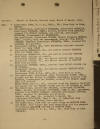
|
2.
11 April 1932.
Record of Events, Eastern Area, Month of
March 1932, Acting Area Commander
Capt. M. Cox,
Bluefields, to Jefe Director GN Managua,
p. 2.
" . . . Mar. 9
Lieutenant LONG, H.F.A., (MC)., GN.,
from Duty to Sick, DENGUE. ¶
Mar. 12 Two amphibians, Lieutenant
PARMELEE, Lieutenant SCHWABLE,
Lieutenant POLLOCK, USMC., pilots,
arrived from MANAGUA, cleared for PUERTO
CABEZAS, and arrived. Lieutenant
SCHWABLE, disembarked at BLUEFIELDS.
¶ Two amphibians, Lieutenant
PUTNAM, Master Sergeant MUNSCH, USMC.,
pilots, with two passengers, arrived
from PUERTO CABEZAS, embarked Lieutenant
SCHWABLE, USMC., cleared for MANAGUA,
and arrived. ¶ Mar. 13
Lieutenant CURGEY, GN., with seventeen
enlisted cleared WUANI for CASA VIEJA.
¶ Mar. 15 Lieutenant SOMARRIBA,
GN., and patrol cleared NEPTUNE MINE for
TUNKY 0720. ¶ Mar. 16
Lieutenant SOMARRIBA, GN., and patrol
returned NEPTUNE MINE 0800.
Nothing to report. ¶
Lieutenant CURCEY, GN., and patrol
arrived CASA VIEJA. ¶ Mar.
17 Lieutenant CURCEY, GN., and patrol
enroute to NEPTUNE MINE from LA LUNA.
¶ Mar. 18 Lieutenant COFFMAN,
USMC., arrived from UNITED STATES via SS
NICARAO. ¶ Lieutenant
CURCEY, CN., and patrol cleared NEPTUNE
MINE for WUANI and arrived. ¶
Lieutenant LONG, H.F.A. (MC)., GN., from
Sick to Duty. ¶ Mar. 19 Two
amphibians, Lieutenant JACK, Lieutenant
CROFT, USMC., pilots, and Mr. Alfred W.
HOOKER, passenger, arrived from MANAGUA,
disembarked Mr. HOOKER, cleared for
PUERTO CABEZAS, and arrived. ¶
Major WOOD, John C., GN., detached from
the Guardia Nacional and sailed for the
UNITED STATES via the SS NICARAO at
2400. ¶ Mar. 20 Two
amphibians, Lieutenant POLLOCK,
Lieutenant PARMELEE, USMC., plots,
Lieutenant RODRIGUEZ, Juan G. GN.,
passenger, arrived from PUERTO CABEZAS,
embarked Lieutenant COFFMAN, USMC.,
cleared for MANAGUA, and arrived.
¶ Captain COZ, Max, GN., promoted
to Major, GN. ¶ Lieutenant
RODRIGUEZ, Juan G., GN., to temporary
duty MANAGUA, witness General Court
Martial. ¶ Mar. 21 Two
Amphibians, flew over and made drops at
NEPTUNE MINE and WUANI. This flight was
made especially for the purpose of
dropping SMALLPOX VACCINE at NEPTUNE
MINE. ¶ Lieutenant LONG,
H.F.A., (MC)., GN., from Duty to Sick
(DENGUE). . . . "
|
|
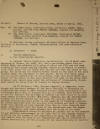
|
3.
11 April 1932.
Record of Events, Eastern Area, Month of
March 1932, Acting Area Commander
Capt. M. Cox,
Bluefields, to Jefe Director GN Managua,
p. 3.
" . . . Mar. 26
Two amphibians, Lieutenant JACK,
Lieutenant CROFT, USMC., pilots, arrived
from PUERTO CABEZAS, cleared for
MANAGUA, and arrived. ¶ Mar.
27 Two amphibians, Lieutenant SAUNDERS,
Lieutenant BINNEY, USMC., pilots,
arrived from MANAGUA, cleared for PUERTO
CABEZAS, and arrived. ¶ 2.
Military duties performed. Military
Police of Eastern Area; Training of
Personnel; Combat, Reconnaissance, and
Administration Patrols. ¶ 3.
CONTACTS: - NONE. ¶ D.
POLICE OPERATIONS. ¶ 1. See
Departmental Reports. ¶ 2.
General Police Conditions, Satisfactory.
On 23 March raso Maximino M. Calero, No.
4530, GN., while preforming guard duty
at MUELLE REAL, was attacked by a group
of about ten (10) men who were working
at that place loading bananas.
Calero in an effort to establish order
fired two (2) shots into the air and
over the heads of the group. The
shots had the desired effect except in
the case of the late Teodulo Diaz, who
attempted to rush Calero. Calero
then fired again and the bullet struck
Diaz in the abdomen. Diaz died on
28 March as a result of the wound.
It has been reported that most of the
group that attacked raso Calero were
under the influence of intoxicating
liquor. Raso Calero is being tried
by Consejo de Guerra General. ¶
On 27 February, 1932, Eustace Campbell,
a Jamaican, bookkeeper and assistant
manager of the Banco Nacional de
Nicaragua in Bluefields was found to
have defaulted certain funds pertaining
to his countrymen which had, in keeping
with an old custom, been turned over to
him for deposit. The shortage at
present has been found to be more than
twenty thousand dollars ($20,000).
Campbell was the intermediate between
the Creole element and the bank. He
received deposits for savings accounts
and also acted in the capacity of
financial advisor. He issued
passbooks with the accounts duly entered
and paid to depositors such amounts as
they demanded from time to time.
Deposits when made, while entered into
the books of the depositors over the
signature of Campbell, were never
entered into the books of the bank.
¶ Considerable unrest is manifest
at present due to the absence of any
definite announcement by the bank that
it will assume responsibility for the
losses of the depositors. In fact,
the bank auditor has implied that the
bank is not responsible and has no
intention of making restitutions.
If the accounts of the depositors are
not paid in . . . "
|
|
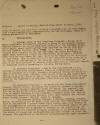
|
4.
11 April 1932.
Record of Events, Eastern Area, Month of
March 1932, Acting Area Commander
Capt. M. Cox,
Bluefields, to Jefe Director GN Managua,
p. 4.
" . . . full, or
should be bank fail to issue a statement
in the near future that it will assume
full responsibility for the shortages,
there is a strong probability of
disorders. ¶ E.
INTELLIGENCE. ¶ 1. General
State of the Territory Occupied – Quiet.
On 8 March unreliable information
reported a group of one hundred bandits
(Leader unknown) in the LA LUNA Mine
District on the OCONGWAS RIVER. On
15 March, small bandit groups were
reported in the LA LUNA MINE and RIO
BAMBANA District below TUNKEY. On
16 March, a group of ten bandits were
reported on the PIS PIS trail ten miles
southwest of LAKOS FARM, traveling
toward the COCO RIVER. On 24
March, NEPTUNE MINE reported that bombs
had been heard by BIG FALLS in the
direction of CASA VIEJA. Patrols
were active in the districts above
referred to but failed to confirm any of
the reports. Bandit information
for the period has been confined to
rumors. There have been no
definite reports of organized bandits
operating in the Area during March.
¶ 2. Military situation: - Due to
the inactivities of the bandits in this
Area during March, there is nothing upon
which to base an estimate as to their
probable intentions during the month of
April. It is believed, however,
that should there be any bandit
activities during the month of April,
that these activities will be confined
to the Department of Northern Bluefields
and the Neptune Mine District. ¶
3. Economic Situation: - On March 19,
The Cukra Development Company (United
Fruit), increased its export of bananas
by approximately sixty thousand (60,000)
stems per month. The improved
conditions in the United States market
operated to effect the resumption of
weekly sailings of the company’s
steamers which had been on a bi-monthly
schedule since January, 1932. Each
steamer now carries about thirty
thousand (80,000) stems of bananas.
¶ The Mexican Traders Company, a
Mobile, Alabama, Corporation, is
operating the SS RAMA, which carries
from twenty-five thousand to thirty-five
thousand stems every twelve days.
The revival of the banana industry
affords employment to an increased
number of laborers and provides for a
maximum of workers on the plantations.
In consequence of the improved economic
situation it is estimated that the
number of unemployed in Bluefields has
been reduced to about one hundred.
The population of Bluefields is
approximately eight thousand . . . ."
|
|
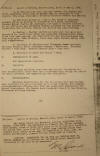
|
5.
11 April 1932.
Record of Events, Eastern Area, Month of
March 1932, Acting Area Commander
Capt. M. Cox,
Bluefields, to Jefe Director GN Managua,
p. 5.
" . . . 4. No
friction has been reported between the
Guardia and civil population other than
at MUELLE REAL as contained in this
report. The press continues a
friendly attitude towards the Guardia.
¶ 5. Political situation – quiet.
Mr. Henry F. Springer, assumed office as
Alcalde of Bluefields on 7 March
succeeding General Eliseo Duarte.
Mr. Springer, has taken a decided
interest in his office and has initiated
several projects for the benefit of
Bluefields. His attitude towards
the Guardia has been friendly. ¶
6. Weather – Weather conditions have
been very good and favorable for
patrolling. River and coastwise
transportation schedules have been
regular, and visibility for air
reconnaissance has been very good.
From 18 March, there were light showers
daily, with cool temperatures. ¶
7. Condition of Telephone and Telegraph
Communications: Civilian Tropical Radio
Telegraph Company – Excellent.
Kisalaya Guardia – Very Good. Guardia
Neptune Mine – Very Good. ¶
8. Condition of Roads and Trails – Good.
¶ F. CONFISCATION OF ARMS. ¶
See Departmental Reports. ¶
G. TRAINING. ¶ Training
schedules have been maintained.
Discipline has been satisfactory.
There were four courts-martials during
the period for minor offenses. Two
Summaries and two Ordinaries. ¶
H. MISCELLANEOUS. ¶ Entrance
examinations for the Nicaraguan Military
Academy were conducted for nine
civilians on 7, 8 and 9 March.
Four Guardia non-commissioned officers
also took the prescribed examination for
Second Lieutenants, GN. Papers
were forwarded direct to the Director,
Nicaraguan Military Academy. ¶
Mr. Ralph Sexton and Mechanic, arrived
BLUEFIELDS from BALBOA, CANAL ZONE, via
aeroplane on 3 March. Mr. Sexton
salvaged four motors, three of which
were found to be in very good condition.
The motors were taken from two wrecked
Army bombing planes that crashed about
twenty miles east of Bluefields in June,
1931. Mr. Sexton and Mechanic,
cleared for the CANAL ZONE on 8 March.
¶ CIVICOS: BLUEFIELDS 75; LA CHUZ
12, NEPTUNE MINE 76. PUERTO
CABEZAS has no civicos but can muster
about twenty-five volunteers in the case
of an emergency. ¶ M. COX ¶
Acting."
|
|
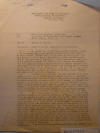
|
17 April
1932.
Informe de Patrulla,
2nd Lt. Francisco
Gaitan, Kisalaya, to Comandante
del Departamento GN, Novena Companía,
Puerto Cabezas, p. 1.
|
|
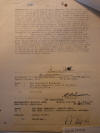
|
17 April
1932.
Informe de Patrulla,
2nd Lt. Francisco
Gaitan, Kisalaya, to Comandante
del Departamento GN, Novena Companía,
Puerto Cabezas, p. 2.
|
|
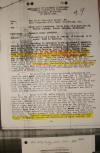
|
1.
22 April 1932.
Information of Attack to Cuartel of
Kisalaya on 21 April, 1932, by Bandits.
2nd Lt. Francisco
Gaitan, Kisalaya, to Department
Commander, Dept. of N. Bluefields, 9th
Company, Puerto Cabezas, p. 1.
"1. According to
reference above mentioned I herewith
furnish you with the following
information. On 20th of this
present month, about 8:00 AM several
pitpans with Mosquito Indians went down
the river from Saulala, Santo Domingo,
Laguna Tara, Pranza and Urapany who the
day before had gone to bring bananas
from their properties and to sell the
bananas to the contractor of the company
E.L.C. of Puerto Cabezas, Señor Eduardo
Araña, who travels by motor boat.
They all stated that they had returned
due to the fact that there were bandits
at Urapany on the Coco River about 30
miles from this Headquarters. On
further questioning they stated that
they had seen the bandits who had gone
after them and that there were many of
them and that two indians who had gone
along with them had disappeared and that
possible had been made prisoners or
killed by the bandits. ¶ 2.
On receiving the above mentioned
information and thinking that
information could be true due to the
fact that that was the route taken by
the deserters Guardias, I considered
that they could be the ones and that had
joined the bandits. I took
preventive measures in order to be ready
against an attack and knowing they had
good arms and ammunition as they took
them from this quarters. I waited
all day long expecting that could be
possible the return of any of the
Indians who disappeared and that I could
get some information about the bandits.
¶ 3. About 3:00 PM, Señor Eduardo
Araña arrived by motor boat from the
Cabo with some provisions for the
Guardia and to buy bananas from the
mosquito and zambos indians. We
did not receive any other information on
the rest of the day. Mr. Araña
placed his motor boat right in front of
the headquarters in the river as usual,
and to clear next day up to the river to
pick up the bananas. About 1:55 AM
of the 21st, bandits started fire
against the headquarters from all sides
except from the side of the river
employing three automatic weapons,
rifles, pistols and hand bombs (tin
cans). Guardia answered them with
rifles, one Thompson and one Browning.
Bandits increased their offensive attack
shouting “vivas” to General Sandino and
liberators of their country, and . . . "
|
|
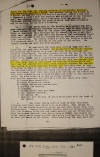
|
2.
22 April 1932.
Information of Attack to Cuartel of
Kisalaya on 21 April, 1932, by Bandits.
2nd Lt. Francisco
Gaitan, Kisalaya, to Department
Commander, Dept. of N. Bluefields, 9th
Company, Puerto Cabezas, p. 2.
" . . . death for
the dogs and country sellers of the
Guardia Nacional. Raso Marcelino
Baquedano #2385, was wounded during the
attack by a bullet through his back but
was not serious. While I was with
a Thompson a bullet from the bandits
struck me on the forehead and I was
bleeding much. Lieut Rodrigues
took the machine and continued shooting
against the bandits while took care of
myself and to continue firing with a
Browning. ¶ 4. All shots
made by the bandits were against the
Officers quarters and Guardia quarters
believing that we were sleeping. I
heard voices to say “Fire at the house
that the machine is there”. “Fire
on that side that trenches are in
there”, it is to say that Rodriguez and
myself had all changed and by that way
avoiding any other casualties. The
attack ceased at 3:00 AM, bandits
retreated to a mountain which is located
on the one side of the valley. The
contact lasted one hour and five
minutes. ¶ 5. On searching
the camp next morning three dead were
found and one seriously wounded, the
ex-sergeant Sebastian Jimenez who
deserted the Guardia on 4 April killing
Lieut Levonski and wounding Lieut Reyes.
He had a bandage around the leg of the
shot received from Lieut Reyes; all the
guardias recognized him, he had high
boots, khaki shirt, Guardia hat and
device and a “38” special pistol.
Another wounded bandit was found who
said was Adres Oviedo, from Leon, that
he had joined the bandits at Palacaguina
and that they had cleared for Bocay,
that Sergeant Jimenez had cheated them
saying to attack Kisalaya Cuartel and
that very easy to take it became he knew
it well, that there were 50 men those
who attacked the Quarters being 12
Guardias among the bandits, that the
rest were civilians, that there were
some more waiting at the ravine and that
their intention was to sack El Cabo and
later to the railroad track. He
died later as he was seriously wounded.
¶ When bandits retreated the
following loot was taken from them: 50
rounds Krag ammunition. 10 Fuses
of dynamite bombs. 60 rounds .38 special
ammunition. 2 pistols .38 special. 2
cutachas. 3 handkerchiefs (red and
black). 1 hat, Guardia Nacional. 1
hat emblem, GN. 1 pamphlet with Picture
of Lieut Pennington with the head of one
bandit. ¶ 6. The blood
trails left by bandits when retreated
indicate that there were about 8 or 10
wounded. They headed to south for
the Leimus mountain, about one and half
league from this headquarters.
During the attack bandits used one
Thompson Machine Gun, one Browning
Rifle, and one Lewis machine Gun and
rifles Krag. When the attack
started, Raso Sabas Cornejo #3473, ran
toward the river taking senor Araña’s
motor boat going in direction of El
Cabo, we have not heard of him since.
After exploring the camp well and . . .
"
|
|
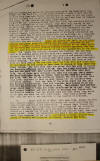
|
3.
22 April 1932.
Information of Attack to Cuartel of
Kisalaya on 21 April, 1932, by Bandits.
2nd Lt. Francisco
Gaitan, Kisalaya, to Department
Commander, Dept. of N. Bluefields, 9th
Company, Puerto Cabezas, p. 3.
" . . .
and not having any means of
communication with the Department
Commander at the Fort due to the lack of
Radio I sent a mail carrier to Moss Farm
Quarters giving information in order to
get the plane for the wounded and to get
treatment for myself and also to inspect
the place of the contact and some other
details. ¶ At 4:00 PM the
planes landed from the Fort, but
aviators did not have any information of
the attack, they were only coming to let
me have some office articles. I
furnished them with all information,
they took with them Raso Baquedano who
was wounded for the Guardia Hospital,
they also gave information to Captain
Inman, Commander of Department of
Northern Bluefields and requested him to
send me ammunition and medicines as I
expected a new attack during the night
as the Guardia deserters had joined with
the bandits. The planes returned
to the port carrying Raso Baquedano who
was wounded. After the planes had
left, an old woman Silvina Martinez,
mosquito indian who was made prisoner by
the bandits a couple of days ago at
Urapany returned to our camp; while she
was with her husband picking bananas
bandits appeared, her husband ran away
but she could not do it and was
apprehended by the bandits. The
night the bandits attacked the Cuartel,
she had been left with another group and
who were as a reserve, she heard the
contact; the bandits with her had only
pistols and muzzle-loaders, but those
who had come to attack were well armed
and had four automatic weapons.
She says that during the contact the
bandits left with her were saying “We
are sure that the boys will get those
bandit Guardias, we are going to tear
them to pieces or hang them” and other
things. She also said that the
group that had gone to attack the
Quarters returned about 5:00 AM, they
had eight seriously wounded and two dead
that were buried there and that four
more were left, two of those were
colonels but they did not say their
names. The four left were those we
found, they stated that did not have any
luck, that one of the automatic weapons
had not fired and that they never
expected to have so many losses but the
Guardias were too sharp shooters.
That the Jefe of the group where she was
left was General Juan Morales, that all
together were around 90 or 100 but they
had only rags and nothing to eat.
They stated that another group would
come to Bocay and other from “minas de
al Luz”, that they will gather together
and will return to Kisalaya and finish
with the Guardia because they had plenty
arms and that later they would go to
sack and turn the rail road track.
Then they released her and told her not
to say anything to the Guardia at
Kisalaya . ¶ 7. After 8:00 AM,
this same date, planes arrived with
Captain Inman, Department Commander and
Lieut Capollony (M), they brought
medicines and ammunition. I showed
Capt. Inman the place where they were
attacking, also where they had the
automatic weapons, articles captured,
also the dead bandits who were not
buried as I wanted him to have the proof
and inspect them, then they were buried.
After the inspection and when I had the
first treatment, they returned to the
port. According to later reports
this group of bandits had returned to
Urapany, Waspook and Bocay. . . . "
|
|
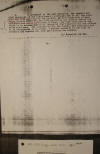
|
4.
22 April 1932.
Information of Attack to Cuartel of
Kisalaya on 21 April, 1932, by Bandits.
2nd Lt. Francisco
Gaitan, Kisalaya, to Department
Commander, Dept. of N. Bluefields, 9th
Company, Puerto Cabezas, p. 4.
" . . .
6. I recommend to the Jefe Director, the
conduct and good behavior of 2nd Lieut
Juan B. Rodriguez and of all the
Guardias who took part during the
contact, with exception of Raso Sabas
Cornejo #3473 GN, who left us during the
contact taking his equipment and about
100 rounds of Krag. Any time this
man be captured it is recommended to be
judged by Court Martial for the offence
above mentioned. The coolness of
all the Guardia was excellent and it is
recommended to be cited. Attached
herewith is the list of Officers and
Guardia who took part during the
contact. ¶ /s/ Francisco
Gaitan."
|
|
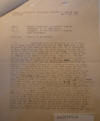
|
26 April
1932.
Report of my Patrol.
Lt. J. E. Rourk
A., Rama, to Col. L. L. Leech,
Bluefields, p. 1.
"1. Left Rama
with ten Guardias the 21 of April, 32 to
chase bandits that were rumored were in
“El Garrobo”. We left there at
11.00 A.M. and got to Quisilala at 1.00
P.M. where we left the motor boat,
ordering the boatmen to return to El
Rama. We left Quisilala at 2.00
P.M. taking the trail for Chontales by
land. At 8.00 P.M., we got to family by
the name of Lopez where I asked for
information, if it was true that 100 men
had passed there, going by the
information I first got at Quisilala . I
was informed that only eight men had
passed there. I was told the trail
that we were going thru was by no means
penetrable by night because it was
closed by fallen trees, and being that
we had our privation on horses I decided
to stay there for the night. The
following morning we got on the trail
again and we got to Monte Verde at 10.00
P.M. after having destroyed four bandit
camps that we met on our way.
Three camps were of the bandits that in
January robbed the Chinese of Muelle
Real. In Monte Verde we were informed
that the 13 of April, eight men with two
horses, one Remington rifle, one Krag
with five bullets each, one pistol and
two shot guns that they had stolen on
their way. The man that informed
us, Pedro Espinoza, was robbed of
everything he had. The same day
they continued on this way to Rio
Siquia. The 15 of April they
returned, carrying the majority of them
two pistols and two horses with a load,
that they told Espinoza that they were
going to sleep about two hundred yards
from his house and if the Guardia
arrived of any Juez De Mesta to notify
them because they were afraid on account
that they had very little ammunition.
We camped there that night and the next
day I made up my mind to go to Salte
Grande where they told me that there
were many accomplices of the robbers.
We left there 5.00 A.M. and we got to
Garrobo at 6.00. . . . "
|
|
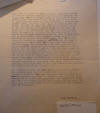
|
26 April
1932.
Report of my Patrol.
Lt. J. E. Rourk
A., Rama, to Col. L. L. Leech,
Bluefields, p. 2.
" . . . P.M.
where we took the road by water.
From there on we started to capture
accomplices. We got to Castillo at
10.00 P.M. where we camped after we got
hold of other robbers. The next
day we left Pilan and we got there at
2.00 P.M. and there we were informed no
robbers had passed there, and that there
were no robbers down the river. We
left the same day getting to Garrobo
where we met the Patrol of sergeant
Chamorro and there we captured other
individuals and with the ones we already
had amounted to ten. The following
day we left here at 5.00 A.M getting to
Muelle Real at 6.00 P.M. and at 10.00
P.M. I sent sergeant Chamorro with five
Guardias to capture some individuals
that had stolen from the Chinese in
January, who had run away to Chontales
and had return three days ago.
From there I left at 5 A.M. and on my
way I got some information where
sergeant Chamorro was because he hadn’t
returned. I sent two guardias to look
for him and they found him waiting for
the men, because they were not here.
Seeing this I continued on my road, from
there near to Rama. We got here at
11.00 A.M. with ten civilian prisoners.
I took away a pistol from a Juez de
Mesta that had never gotten out any
permit to carry arms. Sergeant
Chamorro arrived at 2.00 P.M. with three
civilian prisoners. I also took
away a shot gun from another civilian
that had no permit to use it. ¶
2. Regarding what was said about the
bandits, being one hundred, was that the
eight robbers had told the people to
tell us that they were one hundred armed
with machine guns so we would not follow
them. This has been confessed to
me by all the prisoners that were with
them, and that’s the reason for all the
alarm, but the truth is that they were
only eight dirty bandits from the
neighborhood of Chontales. ¶
J. E. ROURK A."
|
|
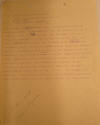
|
26 April
1932.
Radiogram from
Nicaraguan Natl Guard Detachment (Lt.
Hamas), Nueva Segovia, to Jefe
Director GN Managua.
"8628 LIEUTENANT
HAMAS COMMANDING PATROL CONSISTING OF
LIEUTENANTS STORMS VOGEL CABCERA AND
GUTTEREZ AND FORTY FIVE ENLISTED GUARDIA
HAD CONTACT AT POINT TWO ONE THREE DASH
FOUR ZERO EIGHT NUEVA SEGOVIA ON APRIL
TWENTY SIX AT SIXTEEN HUNDRED.
FIGHT LASTED THREE HOURS. PATROL
DISCOVERED AND ATTACKED WHAT IS THOUGHT
TO BE SANDINOS CAMP. SANDINO THOUGHT TO
HAVE BEEN PRESENT DURING FIGHT.
ALSO EX-SERGEANT GARDIA AND EX-CORPORAL
CORNEJO WHO DESERTED FROM QUILALI.
PERICO CAMP CONSISTED OF THIRTY FIVE
SHACKS OF VARIOUS SIZES. BANDITS
ESTIMATED AT TWO HENDRED FIFITY FORMED
FIRING LINE SIX HUNGRED YARDS IN LENGTH
WHILE GUARDIA OCCUPIED A WELL PREPARED
BANDIT DEFENSE POSITION OF ROCKS AND
LOGS ABOUT TWO HUNDRED FIFTY YARDS FROM
THE BANDITS. EVIDENTLY THE BANDITS
HAD TIME TO OCCUPY THEIR DEFENSE POINT
AND RETIRED ACROSS A RAVINE OVER WHICH
THE FIRING TOOK PLACE. BANDITS
TRIED TO ATTACK FROM A FLANK BUT WERE
DRIVEN OFF. THEY THEN SCATTERED."
|
|
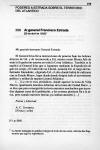
|
28 April
1932.
Letter from Gen.
Augusto C. Sandino, Cuartel
General del EDSNN, to Gen. Francisco
Estrada.
(Source: A. C. Sandino,
El
pensamiento vivo,
v. 2, Sergio Ramirez ed. & comp.,
Managua, Nueva Nicaragua, 1984, p. 219)
"Mi querido
hermano General Estrada: ¶
El General Irías lleva instrucciones de
ponerse bajo las órdenes directas de Ud.
y de reconocerle a Ud. Mismo como Primer
Jefe de toda la Expedición nuestra en
toda la Costa Atlántica. También se le
explicó al General Irías que si logramos
mediante la Expedición de que me ocupo,
el Control de ese Litoral, asumirá Ud.
el cargo de Gobernador Intendente,
eligiendo Ud. el sitio donde habrá de
radicarse con su Estado Mayor, lugar
desde donde dirigiriá todo el movimiento
político y militar de nuestro Litoral
Atlántico. ¶ [ . . . ]
Le envió esos periódkicos, donde aparece
la toma de Villa Nueva; igualmente
tenemos informes de la toma de Ciudad
Darío, y se dice que para conseguirla
tuvieron nuestros muchachos que
incendiar algunas casas de la población,
y los aviones pusieron fin a la tarea,
pero cuando nuestras fuerzas ya estaban
ausentes [ . . . ] ¶ Patria
y Libertad ¶ A. C. SANDINO"
|
|
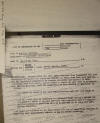
|
29 April
1932.
Inspection Report of the 9th Company,
Puerto Cabezas, by
Major M. Cox, p. 1.
"INSTRUCTIONS:
General Order No. 100, 1929, requires
Area Commanders and Area Executives to
inspect all posts and Guardia in their
area once each quarter, and for
Department Commanders to inspect all
posts and Guardia in their Department
once each month, and to submit a report
on this form to Headquarters, Guardia
Nacional, upon the completion of each
monthly or quarterly inspection. ¶
Only one report is required for each
administrative unit for each month or
quarter. ¶ Posts of a unit
will be inspected at different times
during a period and only one report a
month or quarter for each administrative
unit is required. Submitted
answers to questions will be so phrased
as to cover all posts of Guardia
inspected. ¶ Blank pages are
inserted in the back hereof for use of
inspecting offers in submitting such
supplemental reports as may be deemed
necessary."
|
|
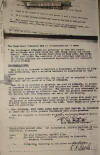
|
29 April
1932.
Inspection Report of the 9th Company,
Puerto Cabezas, by
Major M. Cox, p. 2.
"The Department
Commander had no recommendations to
make. ¶ The buildings at
KISALAYA are generally in very bad
repair. All buildings have palm
roofs and leak badly during the rainy
Season. There are no shower
facilities at this post. Men bathe
in the COCO RIVER. The condition
of all buildings especially so the
living quarters are considered
depressive and not conducive to good
morale. ¶
RECOMMENDATIONS:
¶ That if it is intended to
maintain a detachment of Guardia at
KISALAYA permanently, that a suitable
barracks be constructed at that place.
¶ That under present conditions,
men should not be required to serve more
than (1) month at a time at KISALAYA.
¶ That if it is intended to
maintain the post at KISALAYA, it should
be increased to at least forty (40)
enlisted and three (3) officers, to
properly carry out its mission.
The mission of this detachment in my
opinion is purely an offensive one.
With its present personnel do not
believe that this detachment can carry
out its mission. ¶ That
KISALAYA be furnished at least four (4)
mules with packs for the purpose of
evacuating that place should it become
necessary to withdraw these Guardia to
protect the LINE. These mules
could also be used for patrolling.
¶ That KISALAYA, MOSS FARM, KIPLA
FARM and CAPE GRACIAS, be furnished at
least one (1) rifle grenade discharger
with rifle grenades. ¶ That
all outposts be furnished athletic
equipment. Suggest Volley Ball.
¶ M. COX, Major, GN. ¶
Area Executive Commander"
|
|
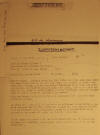
|
1.
30 April 1932.
Inspection Report of the 9th Company,
Puerto Cabezas, by
Capt. O. A. Inman, Puerto
Cabezas, p. 1.
"During this
period ended 30 April, 1932. ¶
INSTRUCTIONS: General Order No. 100,
1929, requires Area Commanders and Area
Executive to instruct all posts and
Guardia in their area once each quarter,
and for Department Commander to inspect
all posts and Guardia in their
Department once each month, and to
submit a report on this form to
Headquarters, Guardia Nacional, upon the
completion of each monthly or quarterly
inspection. ¶ Only one
report is required for each
administrative unit for each month or
quarter. ¶ As posts of a unit will be
inspected at different times during a
period and only one report a month or
quarter for each administrative unit is
required to be submitted answers to
questions will be so phrased as to cover
all posts and Guardia inspected. ¶
Blank pages are inserted in the back
hereof for use of inspecting officers in
submitting such supplemental reports as
may be deemed necessary. . . . "
|
|
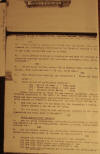
|
2.
30 April 1932.
Inspection Report of the 9th Company,
Puerto Cabezas, by
Capt. O. A. Inman, Puerto
Cabezas, p. 2.
"[ - - - ]
Schedule issued by headquarters, Guardia
Nacional, been carefully followed? (If
not [ - - - ] what training has not been
carried out, why) YES ¶ 2.
What system is employed to insure that
all Guardia in a unit receive the
instructions prescribed in the Training
Schedule? Roster of men under
instruction kept up to date. ¶
3. Is an officer detailed as instructor
and does he actually demonstrate
wherever possible the positions,
movements, etc., being explained?
YES ¶ 4. Is the daily
routine prescribed by Headquarters,
Guardia Nacional, being complied with?
(If not, state why.) YES ¶
5. What drills were held for the
inspection? Close and extended
order. ¶ 6. State degrees of
proficiency shown in: (a) Manual of
Arms: Very Good, (b) Close order Drill:
Very good, (c) Extended order Drill:
Good ¶ (Note. The
manner in which the men execute
Inspection Arms is a fallible indication
of the amount of Troop Inspection made
by Officer. Where many show awkwardness
and unfamiliarity of this movement it
indicates neglect of orders in carrying
out the prescribed routine.) ¶ 7. How
many men fell out for drill for the
inspection? Twenty, Puerto Cabezas; all
men in Out Posts. ¶ 8. Did
the drills indicate that sufficient
progress in the training prescribed was
being made by men? YES ¶
RIFLE MARKSMANSHIP TRAINING ¶
1. Are the rifle marksmanship
instructions prescribed in the Training
Schedule issued by Headquarters, Guardia
Nacional, being carefully carried out?
YES ¶ 2. Has instructor
studied all instruction references and
prepared himself sufficiently well to
instruct in this subject? YES ¶
3. Inspect all rifles carefully and note
the following: (a) How many rifles are
in suitable condition for range firing?
[?] (b) How many front sights were
defective? One (c) How may rear
sights were defective? Two (d) How many
were otherwise found defective for
marksmanship on the range? . . . "
|
|
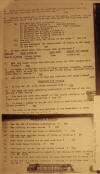
|
3.
30 April 1932.
Inspection Report of the 9th Company,
Puerto Cabezas, by
Capt. O. A. Inman, Puerto
Cabezas, p. 3.
" . . . 4. Have a
sufficient number of prescribed aiming
devices been constructed and completed
for instruction use? YES ¶
5. Conduct an examination of all men in
the aiming, position, trigger squeeze,
and rapid fire exercises and then answer
the following questions: How many men
were proficient … In the aiming
exercise? All but fifteen, In
assuming the prone position? (15)
recruits, In squeezing the trigger?
In assuming the sitting position?
In assuming the kneeling position? In
assuming the standing position? In
adjusting the sling? (b) Are all
men ready for firing on the range?
All but recruits. (c) Do you
recommend the commencement of firing on
the range by the men? YES ¶
6. At what places have rifle ranges been
constructed? Station - Puerto Cabezas,
Land owned by - Bilway Indian Community,
Rent paid - None, Leased for period –
Indefinite ¶ 7. Are all
ranges fully completed and ready for
rifle marksmanship firing? YES
¶ 8. Is there a sufficient supply
of range material (targets, spotters,
pasters, etc.) on hand for practice and
record firing purposes? (If not
state what is lacking) . YES ¶
9. How much ammunition is on hand and
available for range firing? NONE
¶ SCHOOLING FOR GUARDIA ¶ 1.
Is G.O. No. 57, 1929, being complied
with? YES ¶ 2. How
many men were undergoing instruction on
the day of the inspection? (20)
Twenty ¶ 3. How many men
have been taught to read simple
sentences and their names since last
inspection? Two (2) ¶
4. Is there a supply of proper text
books on hand available for use of the
students? YES ¶ 5. How
many instructors were employed in the
Department or other unit on the day of
the inspection? ONE . . . "
|
|
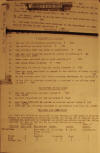
|
4.
30 April 1932.
Inspection Report of the 9th Company,
Puerto Cabezas, by
Capt. O. A. Inman, Puerto
Cabezas, p. 4.
" . . .
INSPECTION OF CLOTHING ¶ 1.
Was the fit of clothing satisfactory?
YES ¶ 2. Was clothing
properly marked? YES ¶
3. Was clothing neat and clean in
appearance? YES ¶ 4.
Did men have required number of pieces
of clothing? NO See G.O. 50, 1928
. ¶ 5. Were shoes polished and in
good condition? YES ¶
6. Are shoes being repaired? YES ¶
7. Were hats of proper size and neatly
blocked? YES ¶ 8. Have
man been cautioned in regard to the
selling of their clothing G.O. 27, 50/28
¶ 9. Do the records show that
there are many checkages for clothing?
YES ¶ 10. Is the fit of
clothing carefully supervised by an
officer when issued? YES ¶
INSPECTION OF EQUIPMENT ¶ 1.
Was this equipment properly marked?
YES G.O. 52/28 ¶ 2. In what
condition was the equipment? Fair
¶ 3. Are forms G/N-1612 QM posted
in service record books? YES G.O. 51/28
¶ 4. Were all men properly
equipped in accordance with G.O. 51,
1928? ¶ BARRACKS AND BUILDINGS ¶
1. List all buildings occupied by the
Guardia in the Area or Department (Note:
If Government or municipal owned, so
state. If no changes occured information
need to be repeated on every inspection
report but reference will be made to the
report on which initially entered.)
¶ Station – Ptocabezas, Occupied –
4, For use as – Barracks, Offices &
Hospital, Owner – B.B.L. Co, Rental -
$25.00, Time of Lease – Indefinite
¶ Station – Kipla, Buildings
Occupied – 1, For use as – Cuartel,
Owner – B.B.L. Co., Rental – None, Time
of Lease – Indefinite ¶
Station – Moss, Buildings Occupied – 1,
For use as – Cuartel, Owner – B.B.L.Co,
Rental – None, Time of Lease –
Indefinite ¶ Station –
Toledo Nye, Buildings occupied – 1, For
use as – Cuartel, Owner – B.B.L.Co,
Rental – None, Time of Lease –
Indefinite . . . "
|
|
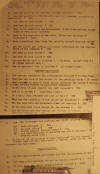
|
5.
30 April 1932.
Inspection Report of the 9th Company,
Puerto Cabezas, by
Capt. O. A. Inman, Puerto
Cabezas, p. 5.
" . . . Station –
Micalaya, Buildings Occupied – 1, For
use as – Barrack, Owner – Marshal,
Rental – None, Lease - Indefinite
¶ Station - Cabo Gracias,
Buildings Occupied, 1, For use as –
Office, Owner – Mr. Green, Rental –
None, Lease – Indefinite ¶
2. Are the lighting and sewage systems
adequate? YES ¶ 3. Are
the quarters of the enclosed men well
arranged, adequate and comfortable?
YES ¶ 4. Are they in good
police? YES ¶ 5. Are
they in good repair? YES ¶
6. What is the condition and arrangement
of the furniture and bunks? Bunks
in rows along Bulkhead. ¶ 7.
What is the condition of the walls,
floors and ceilings of buildings?
Good. ¶ 8. Have
presentations been taken for security
against fire and theft? YES
¶ 9. Are the toilet and bathing
facilities sufficient for the
requirements of the commands? YES
¶ 10. Are they in good repair?
YES ¶ 11. Are they in good
police? YES ¶ 12. How
are rifles kept in quarters? (In racks,
against wall?) In racks against wall.
¶ 13. How is equipment kept in
quarters? In locker boxes. ¶
MESSING FACILITIES ¶ 1. How
are men throughout the organization
rationed? General Mess. ¶
2. What was the cost of the ration for
the preceding month? 19 cents ¶
3. What method is used to check ration
purchases and issues? Purchased by
Mess Officer checked by Department
Commander. ¶ 4. Is the food
of good quality and well prepared? YES ¶
5. How is it served? Cafeteria style. ¶
6. Is a daily menu prepared and kept on
file? YES ¶ 7. What
was the condition of the galley and
equipment? GOOD ¶ 8.
Was the mess hall and equipment clean
and sanitary? YES ¶ 9.
Is the mess hall large enough for the
command? YES ¶ 10. Are the facilities
for receipt and storage of articles of
the station satisfactory? YES. . .
. "
|
|
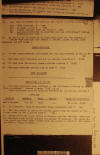
|
6.
30 April 1932.
Inspection Report of the 9th Company,
Puerto Cabezas, by
Capt. O. A. Inman, Puerto
Cabezas, p. 6.
" . . . 1. Are
the storerooms for clothing and public
property adequate? YES (a) Well
arranged? Yes (b) In good police? Yes
(c) Secure against fire and theft? Yes
(d) Are keys entrusted to enlisted men
and civilians? During working hours
only. ¶ 2. Is the supply of
clothing on hand sufficient for the
command? (State what articles are
needed.) Shirts, under shirts, hats,
ornaments and hat cords. ¶
TRANSPORTATION ¶ 1. Is the
transportation sufficient for the
requirements of the Unit? NO
¶ 2. How many motor vehicles are
not in running condition? NONE
¶ 3. Of what does the animal
transportation consist? NONE
¶ 4. How many captured animals are
on hand? None ¶ POST
EXCHANGE ¶ PRISONERS AND
PRISON ¶ 1. How many
prisoners were confined at the different
stations on the dates inspected? Puerto
Cabezas (11) eleven. Note.
Prisoners will be actually verified by
inspecting officer.) ¶
CIVILIAN ¶ Station – Puerto
Cabezas, Guardia – Two (2), Male (11),
Female -----, Date of Inspection – 30
April, 1932 ¶ 2. Is a
Registry Book of Prisoners being
carefully kept? Yes ¶
3. Did the number of prisoners counted
agree with the number of prisoners shown
by the Registry Book? Yes ¶
4. Check prisoners daily ration
statements for the ten days preceding
the inspection and report whether the
number of prisoners for which rations
credit has been taken agrees with the
number as shown by the Register Book as
being confirmed. . . . "
|
|
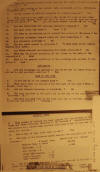
|
7.
30 April 1932.
Inspection Report of the 9th Company,
Puerto Cabezas, by
Capt. O. A. Inman, Puerto
Cabezas, p. 7.
" . . . 5. Were
any prisoners having more than six (6)
months or more to serve confined?
No ¶ 6. Are the Guardia at
the carcel well instructed in the
performance of their duty? Yes
¶ 7. Is the number of sentries
adequate enough to prevent escapes?
Yes ¶ 8. When prisoners are
taken out of the carcel for work or any
other reason as they checked “out” and
“in” as they are taken from and returned
to the prison?” Yes. Are
prisoners worked outside of the prison?
Yes ¶ 9. Are the facilities
for policing prisoners adequate?
Yes ¶ 10. How many cells are
there? Four (4) ¶ 11.
Are they so constructed as to prevent
the escape of prisoners? Yes
¶ 12. Have any prisoners escaped
since the last inspection? No
¶ 13. Are prisoners uniformed?
No ¶ 14. How are meals
served to prisoners? In Mess Hall
after regular Guardia have eaten.
¶ 15. Are there adequate
accommodations for women prisoners?
No ¶ 16. What was the police
condition of the prison on the date of
the inspection? Good ¶
17. What is the general condition of the
buildings and grounds of the prison?
Good. ¶ SANITATION ¶ 1. Are
all buildings and grounds in the
Department or place being inspected in
good sanitary condition? Yes ¶
CARE OF THE SICK ¶ 1. Is the
health of the command good? Yes
¶ 2. What facilities are available
for the care of the sick? Well
equipped Sick Bay ¶ 3. Are
any changes necessary or desirable?
No ¶ 4. How many men were on
the sick list on the day of the
inspection? Thirteen (13) ¶
5. How many men have been on the sick
list due to venereal disease since last
inspection? Fifteen. . . . "
|
|
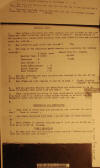
|
8.
30 April 1932.
Inspection Report of the 9th Company,
Puerto Cabezas, by
Capt. O. A. Inman, Puerto
Cabezas, p. 8.
" . . . DEFENSE
PLANS ¶ 1. What scheme of
defense has been planned for the defense
of the barracks and other buildings
occupied by the Guardia?
Concentration of all guardia in a
controlled position with good field of
fire and covered exits for patrols.
¶ 2. Has a Call to Arms order been
issued? Yes ¶ 3. How
many of the following arms weapons are
available for defense purposes?
Machine Guns: 6 Heavy Brow., 6 Lewis,
Ammunition for Rounds – 23,000,
Thompsons: 2 Ammunition for Rounds 9,
995, Auto Rifles: 2, Rifle G discharger:
2, Rifle Grenades: 172, Hand Grenades:
18 ¶ 4. Are all officers and
some reliable men trained in the use of
the above weapons? Yes ¶
5. How often are such weapons as may be
on hand – Fired: Monthly, Cleaned:
Biweekly ¶ 6. Are all
guardia weapons and ammunition not
authorized to be in hands of guardia
kept under lock and key? Yes
¶ 7. What precautions are taken to
keep serviceable automatic weapons from
being used by a possible enemy either
within or without the [?] Essential
parts removed and placed under lock and
key. ¶ RECREATION AND
AMUSEMENTS ¶ 1. What form of
recreation and amusements are provided
for enlisted men? None at present . ¶
2. Are there organized football,
basketball or other athletics? No
¶ 3. What liberty is granted
enlisted men? 2:00 p.m. to 11:00
p.m., 3:00 am to 11:00 pm Sundays
¶ FIRE PRECAUTION ¶ 1.
Of what does the fire fighting force
consist? Lumber Co. [?] cart and command
with buckets. . . . "
|
|
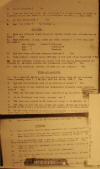
|
9.
30 April 1932.
Inspection Report of the 9th Company,
Puerto Cabezas, by
Capt. O. A. Inman, Puerto
Cabezas, p. 9.
" . . . 2. Is it
adequate? Yes ¶ 3.
When was the last fire bill published?
(Attach a copy to first inspection
report and refer to it in subsequent
reports.) 1 Jan. 1932 ¶
4. Is fire drill held? Yes ¶
(a) How often? Bimonthly. ¶
OFFICERS ¶ 1. Have all
officers their files of Guardia Orders
and publications up to date? Yes
¶ 2. What officers, if any, speak
and read Spanish? (Give full name
and rank). 1st. Lieut. Robert L
Peterson, 2nd. Lieut. Hutchcroft, 2nd
Lieut. Thompson ¶ 3. Are the
other officers studying Spanish? Yes
¶ 4. Does harmony prevail among
officers of the unit being inspected?
Yes ¶ Do the officers
frequently confer with the various
Departmental Officials to maintain
cordial and harmonious relations?
Yes ¶ 5. Are the relations
between officers and men cordial?
Yes. ¶ FUNDS AND ACCOUNTS
¶ 1. Is a cashbook showing all
Government funds received and expended
being properly kept? (GO #33, 1927 and
GO 63, 1928)? Yes. ¶ 2. Are
all expenditures made in an authorized
manner? Yes. ¶ 3. Are
copies of all receipt and expenditure
vouchers being carefully filed?
Yes. ¶ 4. When was the cash
account last audited by an inspector?
[?] 5. Is an allotment book being
properly kept? ¶ 6. The cash
was counted on 28 April and found to be
$4,322.74 ¶ 7. The cash
account and all papers and books
pertaining thereto was audited on 28
April. A separate report thereon
is attached hereto. ¶ 8. Do
the cash accounts of district commanders
or other officers whom cash has been
advanced by another officer [?] . . . "
|
|
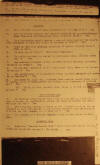
|
10.
30 April 1932.
Inspection Report of the 9th Company,
Puerto Cabezas, by
Capt. O. A. Inman, Puerto
Cabezas, p. 10.
" . . . . 11. Are
receipts obtained for all such
purchases? Yes ¶
PROPERTY ¶ 1. Is a property
account being carefully and properly
kept? Yes ¶ 2. Are
memorandum receipts for property
obtained by Department Commanders from
Area Quartermasters being carefully
filed? Yes ¶ 3. Is a
memorandum receipt property account
being kept by the Department Commander
to show the count of property on hand?
Yes ¶ 4. When was the last
physical inventory of public property
taken? Feb. 6, 1932 ¶
5. By whom was it taken? Department
Commander. ¶ 6. Is public
property in use and in storerooms being
properly cared for? Yes ¶
7. Are retained vouchers to the property
account properly numbered, briefed and
filed? Yes ¶ 8. Is
property purchased in the open market
being taken up on property account?
Yes ¶ 9. Are certificates of
expenditures being properly prepared and
rendered as required? Yes ¶
10. Are forms No. 1612 being detached
from service record books prior to
sending books to Headquarters for
closing upon discharge of enlisted men?
Yes ¶ (a) If so, is this
property being taken up on the property
account? Yes ¶ INTELLIGENCE DATA
¶ 1. Is there an intelligence file
(box or cabinet) in which all papers of
secret and confidential nature are filed
in folders and kept under lock and key?
Yes ¶ 2. Are “Guardia
Rewards” posted on the bulletin board in
the men’s quarters so that each member
of the Guardia can keep himself
acquainted with the men that rewards are
offered for? Yes ¶ 3.
Is a folder of “Guardia Rewards” kept in
the police station? Yes ¶
ORDNANCE DATA ¶ 1. Does the
“Weapons Record Book” show a complete
record of [?] and deposited weapons?
(GO 89/28) Yes . . . "
|
|
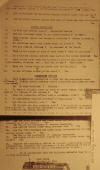
|
11.
30 April 1932.
Inspection Report of the 9th Company,
Puerto Cabezas, by
Capt. O. A. Inman, Puerto
Cabezas, p. 11.
" . . . 2. Does
the “Arms Permit Record Book” show a
complete record of all arms permits
handled by the Department concerned? (GO
9/28) Yes ¶ 3. Are
confiscated and deposited weapons
secured under lock and key? Yes
¶ 4. Are deposited weapons tagged
with name of owner and date of deposit?
Yes ¶ POLICE OPERATIONS
¶ 1. By whom are arrests made?
Municipal Guardia ¶ 2. How
are prisoners taken to the police
station? On foot ¶ 3.
What special orders are issued to
patrolmen? Orders printed on
cards. ¶ 4. Do patrolmen
carry such orders while on patrol?
Yes ¶ 5. How are reliefs
effects? By sergeant of the Guard.
¶ 6. What is the length of the
time of each watch? Four to six hours.
¶ 7. Is a blotter showing arrests
made kept at the police station?
Yes ¶ 8. What record other
than the blotter is kept to show arrests
made, confinements, releases, etc., from
day to day? Card index. ¶
9. Does the Police Judge cooperate with
the Guardia? Yes ¶ 10.
Do any officers attend police court?
Yes ¶ COMMANDING OFFICER
¶ 1. What theoretical instruction
is held for the non-commissioned
officers? N.C.Q. school infantry
combat principles and authentic weapon
school. ¶ 2. Is there a
bulletin board on which to place orders,
etc. to be read by the members of the
command? Yes ¶ 3. Does
the commanding officer keep a punishment
book? Yes ¶ 4. Do
punishments conform strictly to
regulations? Yes ¶ 5.
Are the men promptly paid? Yes
¶ (a) By whom are they
actually paid? (Be explicit in
answering this question).
Department Commander or Dept.
Quartermaster. Always by a
commissioned Marine Officer. ¶
6. Are all officers and men required to
wear the prescribed uniform? Yes .
. . "
|
|
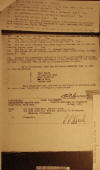
|
12.
30 April 1932.
Inspection Report of the 9th Company,
Puerto Cabezas, by
Capt. O. A. Inman, Puerto
Cabezas, p. 12.
" . . . 10. Are
the first sergeant and clerk being
instructed and trained in preparation of
payrolls? Yes ¶ 11.
Are service record books being properly
kept? Yes ¶ 12. Are
the first sergeant and clerk being
instructed how to keep the service
record books? Yes ¶
(a) Who is the instructor? Company
Commander. ¶ 13. Are copies
of all routine reports and other papers
being properly filed? Yes ¶
14. Request the commanding officer to
furnish a memorandum giving his
commendation regarding the improvement
of the efficiency of his command or make
a statement that he has no
recommendation to make. ¶ It
is recommend that the following athletic
Gear to sent to this Department. ¶
6 Base Balls, 5 Gloves, Base Ball, 1
Mitt Catcher, 1 Volley Ball, 1 Basket
Ball ¶ This Department has
received no allotment of athletic goods
in over a year regardless of frequent
requisitions. ¶ O. A. Inman"
|
|
|
|
|
PREVIOUS
NEXT |
|
|
|
|
|
|
|

